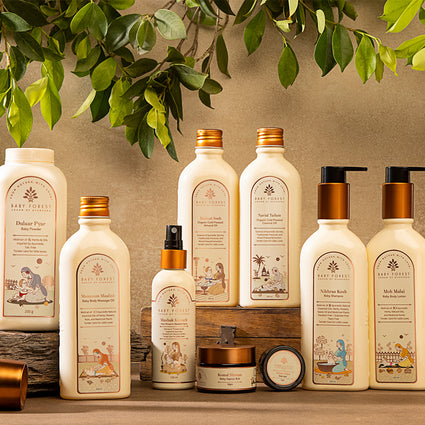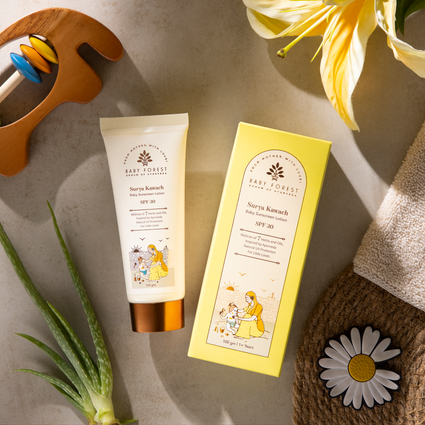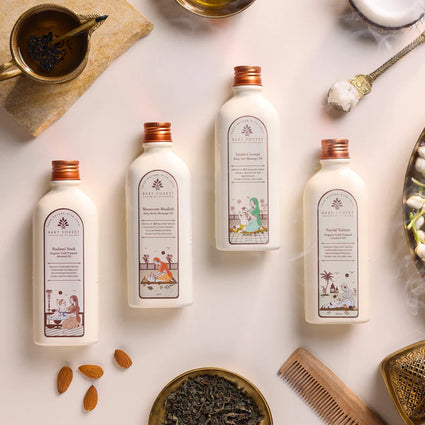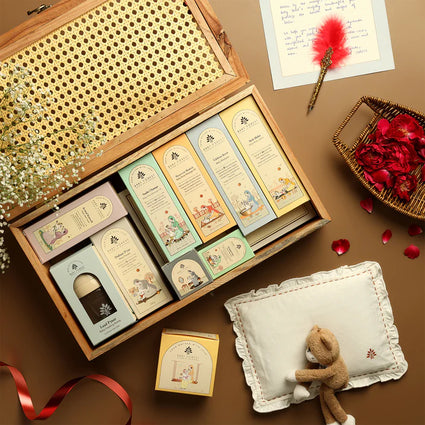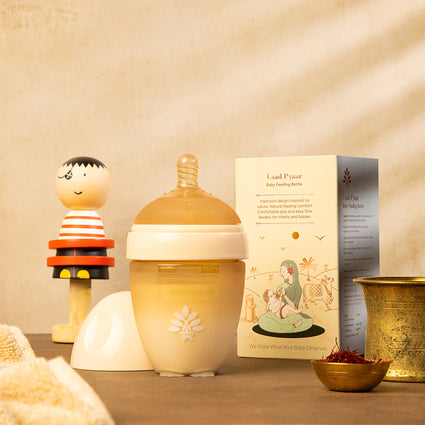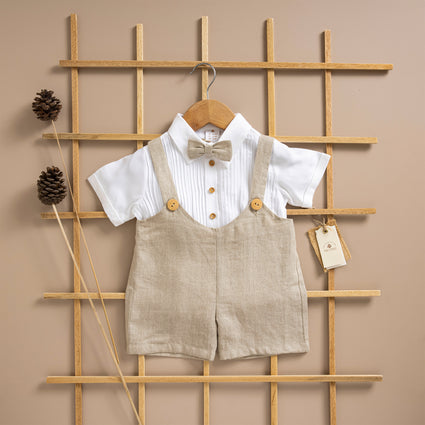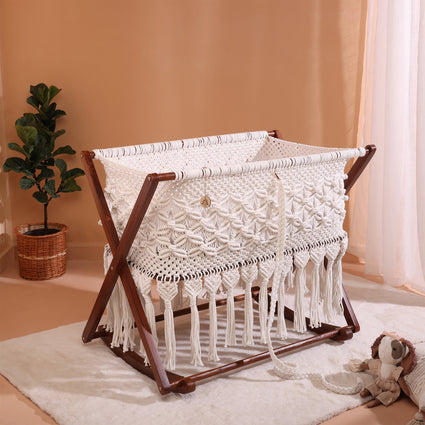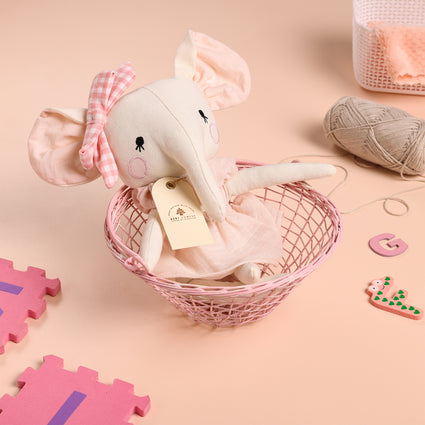Baby Care & Parenting Blogs

The Ultimate Baby Bathing Checklist for Your Baby's First...
Bringing your newborn home is a magical and joyous moment, but it also comes with a list of responsibilities, one of which is your baby's first bath. Bathing newborns is one of the things that many new parents worry about. We are familiar with the emotion. Even the most composed person can become anxious when bathing a newborn for the first time!
Fret not! We've crafted the ultimate baby bath essentials checklist to ensure that this special moment is not only stress-free but also a memorable bonding experience between you and your bundle of joy.
Bath time is a great chance for you and your baby to bond. It's also a great way to just relax and have fun.
Creating the Base for a Successful Baby Bathing Experience

-
Gather Your Supplies
Gather all the essential items for your baby bath products ahead of time – collect baby oil, gentle baby soap, a soft washcloth, baby shampoo, baby lotion, and a comfortable hooded towel. This practice will help you avoid the need to leave the baby unattended during the bath to search for these essential items.
-
Choose the Right Time
The timing is entirely in your hands, but it's recommended to choose a moment when you have the luxury of time and won't feel rushed. Aim to give your newborn baby's first bath within a week of birth, steering clear immediately after feeding or when they're overly tired.
Babies are often more alert in the morning, making it a favourable time for some parents. Alternatively, others may prefer scheduling the baby's first bath in the early evening as part of the bedtime routine. During the wind-down process, consider incorporating the bath into a calming sequence that includes a final bottle or nursing session, reading a book, and a gentle lullaby.
-
Maintain a Comfortable Room Temperature
Babies are sensitive to temperature changes, so ensure that the room is comfortably warm. A chilly environment can make the baby uneasy, while a hot room may lead to overheating.
How to Give a Newborn First Bath?
-
Pre-Bath Preparations:
Begin by organizing all the baby bath essentials within arm's reach. This prevents you from scrambling for supplies while holding a slippery baby. Lay out a soft towel on a flat, secure surface, such as a changing table, and keep diapers and clothes nearby for a swift post-bath routine.
-
Fill the Tub with Warm Water
Babies lose body heat rapidly, especially when undressed, so it's crucial to ensure the bathwater is at a comfortable temperature. Fill the baby bathtub with about 2 to 3 inches of warm water, ensuring it's not too hot. You can test the water temperature with your elbow or a bath thermometer; it should be around 37°C (98.6°F).
-
Undress the Baby
Gently undress your baby, cradling their head and neck with one hand. It's advisable to keep the baby's head above water and support their neck and back throughout the bath.
-
Gently Clean the Baby
Using a soft washcloth, gently cleanse the baby's face without soap. For the rest of the body, use a small amount of natural baby bath products. Pay special attention to skin folds, such as the neck, armpits, and diaper area. Be cautious around the umbilical cord stump; keep it dry and clean until it falls off naturally.
-
Rinse and Dry
After washing, gently pour clean, warm water over the baby's body to rinse off any soap. Once the bath is complete, promptly wrap the baby in a soft, hooded towel to keep them warm. Pat the skin dry, ensuring all creases are moisture-free to prevent irritation.
-
Post-Bath Care
Apply a gentle baby lotion to keep the skin moisturized. Dress the baby in a clean diaper and comfortable clothing. Remember, the first few baths should be brief—about 5 to 10 minutes—to prevent the baby from getting too cold.
Additional Tips for a Smooth Baby Bathing Experience
-
Stay Calm and Confident
Your baby can sense your emotions. Maintaining a calm demeanour will help your baby feel secure during their newborn baby's first bath.
-
Safety First
Never leave your baby unattended during bath time. If you need to step away, wrap the baby in a towel and take them with you.
-
Make It Enjoyable
Sing or talk to your baby during the bath to make the experience pleasant and engaging.
For parents searching for the best baby bath products in India, choosing natural baby bath products is a wonderful way to prioritize your baby's delicate skin. With the right baby bath essentials, you'll master how to give a newborn your first bath in no time!
Bathtime is a delightful experience for both babies and their new parents. Even if your little one appears less than thrilled initially, keeping the event short and sweet can make a world of difference. Before you know it, the sound of running water will have your baby squealing with joy. After the bath, remember to dry your baby gently with a soft towel and add a touch of Moh Malai Baby Body Lotion for an extra dose of post-bath comfort.
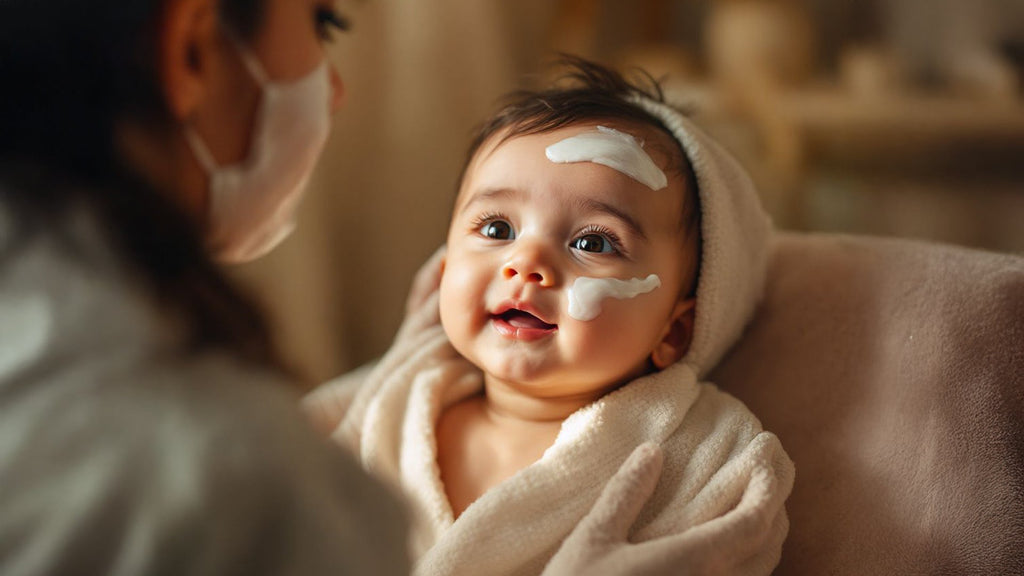
Does Your Baby Need Face Cream? Here's What You Should Know
As a new parent, it's totally normal to wonder about the best ways to care for your baby's delicate skin. You've probably seen a ton of products out there marketed as essentials, but when it comes to baby face cream, is it really necessary? Should you be adding it to your baby care routine? Let's break it down and help you make an informed decision.
Understanding Your Baby's Skin
Babies are born with soft, smooth, sensitive, and still-developing skin. Unlike adults, their skin is thinner, more porous, and more prone to irritation. Plus, it cannot protect itself from environmental stressors like the sun, wind, or pollution. That's why many parents turn to baby face cream that can help shield and hydrate their little one's skin.
However, while their skin might need some extra care, not all products are the right fit. So, let's take a closer look at whether a baby face cream is necessary for your baby.
Does Your Baby Need Face Cream?
In most cases, your baby's skin might not need baby face cream. Newborns and infants usually don't require a complicated skincare routine-just a gentle bath and a mild moisturizer, like baby lotion, will do the trick. Their skin typically does a great job if it's not exposed to harsh conditions.
That said, baby face creams aren't a bad idea either. Sometimes, your little one's skin might need a little extra TLC. If they have dry patches, redness, or irritation, a baby face cream could be just what they need to feel more comfortable. But don't jump to conclusions just yet-let's dive into how you can figure out if your baby really needs one.
Signs Your Baby May Need a Face Cream
There are a few tell-tale signs that your baby might benefit from baby face cream. Here are some of the most common:
-
Dry Skin:
If your baby's skin is feeling rough or flaky, especially on the face, it may be a sign they need some extra moisture. -
Chapped Skin:
Exposure to wind, cold air, or frequent drooling can cause your baby's skin to become chapped, particularly around the cheeks and chin. -
Eczema:
Babies with eczema or other skin conditions may have inflamed or itchy skin, making a soothing baby face cream an important part of their routine. -
Redness or Irritation:
Sometimes, certain environmental factors or even a diaper rash can cause irritation on the face. A gentle, calming cream could help.
If you notice any of these signs, a baby face cream could be helpful in providing extra hydration and soothing relief. But make sure to consult your pediatrician before trying any new products.
What to Look for in a Baby Face Cream
Choosing the right baby face cream can be tricky with all the options available. To make sure you're picking a safe and effective product, here are some key things to look for:
-
Gentle Ingredients:
Look for creams that are free of harsh chemicals, fragrances, or dyes. Natural and organic ingredients like shea butter, aloe vera, and chamomile is great for soothing sensitive skin. -
Hypoallergenic:
Babies can have sensitive skin that's prone to reactions. Opt for a hypoallergenic cream to reduce the risk of irritation. -
Moisturizing:
Since your baby's skin needs plenty of hydration, choose a baby face cream that has moisturizing ingredients such as glycerin, jojoba oil, or coconut oil. -
Non-Comedogenic:
Some creams can clog pores. For babies, look for creams that are non-comedogenic to avoid breakouts or rashes. -
Derma Safe:
Products that are derma safe are often safer and more reliable for your baby's skin.
By paying attention to these qualities, you can choose a baby face cream that will keep your baby's skin soft and hydrated without risking any adverse reactions.
How to Use Baby Face Cream Safely
If you've decided that a baby face cream is right for your little one, it's essential to apply it safely. Here are some tips to keep in mind:
-
Start with Clean Skin:
Always clean your baby's face before applying any cream. Use a gentle, baby-friendly cleanser to remove dirt or impurities. -
Test First:
Before applying a new product, do a patch test on a small area of skin to check for any allergic reactions. -
Use a Small Amount:
Babies don't need a lot of products. A tiny dab of baby face cream is enough to cover their face. -
Gently Massage:
Apply the cream in gentle circular motions to help it absorb into the skin.
By following these simple steps, you'll ensure that you're using baby face cream safely and effectively.
Benefits of Using a Face Cream for Your Baby
Using a baby face cream can offer a range of benefits for your baby's skin, including:
-
Moisture Retention:
Baby skin is more prone to drying out, especially in harsh weather conditions. A nourishing cream locks in moisture and helps prevent dryness. -
Protection from the Elements:
Whether it's cold air or direct sunlight, a good face cream provides an extra layer of protection against environmental stressors. -
Soothing Relief:
For babies with skin irritations, rashes, or eczema, a baby face cream can help soothe the skin and reduce discomfort.
With the right product, a baby face cream can keep your little one's skin soft, protected, and comfortable all year round.
Conclusion
So, does your baby need baby face cream? It really comes down to your baby's skin and any specific concerns you might have. For a lot of babies, a gentle moisturizer does the job just fine. But if your little one has dry patches, redness, or other skin issues, a baby face cream could be exactly what they need. Just make sure to pick one with safe, gentle ingredients, and always check with your pediatrician if you're unsure. At the end of the day, you're doing your best to keep your baby happy, healthy, and comfortable!

Winter Dry Skin in Babies: Why Lotion is a Must-Have This...
Winter brings a chill in the air, cosy blankets, and festive cheers. But for babies, it also brings dry, flaky skin that can be uncomfortable and even painful. As parents, you want your baby to feel soft, smooth, and happy in their delicate skin. That's where baby lotion comes to the rescue, especially organic ones that nurture and protect without any harsh chemicals.
Ingredients like shea butter, coconut oil, and almond oil work wonders for hydration. For example, the Moh Malai Baby Body Lotion use these natural elements to deeply moisturize and nourish, keeping your baby's skin supple and glowing even in winter. Shea butter locks in moisture, coconut oil softens, and almond oil ensures smoothness-all while being gentle and safe.
With the right baby lotion, winter can be all about cuddles and comfort for your little one!
Why Baby Skin Needs Extra Care in Winter
Baby skin is so much thinner and more delicate than ours, making it prone to losing moisture quickly-especially during winter. Dry air outside and heaters inside can leave their skin feeling parched, sensitive, and even itchy.
In cold weather, natural oils in the skin disappear faster, often leading to redness, irritation, or even eczema. Since babies can't tell us they're uncomfortable, you might notice extra scratching, fussiness, or dry patches. That's why using a gentle, organic baby lotion regularly is a game-changer. It not only locks in moisture but also protects their skin barrier and soothes irritation, keeping your little one comfy and happy all winter long!
Benefits of Using Lotion for Winter Dry Skin
Using baby lotion in winter isn't just about adding a soft touch; it's about protecting your baby's health. Here are some benefits:
-
Hydration:
A good baby lotion replenishes lost moisture, keeping the skin soft and supple.
-
Barrier Protection:
Organic lotions often contain natural oils like coconut, almond, or shea butter, which form a protective barrier against harsh elements.
-
Healing Properties:
Many organic baby lotions have ingredients like aloe vera or calendula, which soothe redness and heal minor irritations.
-
Prevents Cracking:
Consistent use prevents severe dryness that can lead to painful cracks or bleeding.
-
Comfort:
Babies with well-moisturized skin are less likely to scratch and fidget, leading to better sleep and happier moods.
Choosing the Right Baby Lotion for Winter
Not all lotions are created equal. When choosing a baby lotion for winter, here are a few things to keep in mind:
-
Go Organic:
Organic baby lotion is free from harmful chemicals, synthetic fragrances, and dyes. It's gentle and safe for sensitive baby skin. -
Look for Moisturizing Ingredients:
Natural ingredients like shea butter, cocoa butter, and almond oil are excellent for deep hydration. -
Hypoallergenic Options:
If your baby has sensitive skin, choose a lotion labelled hypoallergenic to reduce the risk of irritation. -
Fragrance-Free or Mildly Scented:
Strong fragrances can irritate delicate skin. Opt for unscented or naturally scented products. -
Test First:
Always do a patch test on a small area of your baby's skin to ensure there's no allergic reaction.
Tips for Applying Lotion Effectively
Applying baby lotion isn't just about slathering it on. There's a technique to make it work better:
-
Apply After Bath Time:
Moisturize your baby immediately after a bath while their skin is still damp. This helps lock in the moisture. -
Use Gentle Motions:
Use light, circular motions to apply the lotion. Avoid rough rubbing. -
Don't Forget the Creases:
Pay attention to areas like behind the knees, elbows, and neck folds where dryness often hides. -
Keep It Handy:
Reapply throughout the day, especially on exposed areas like the face and hands. -
Warm the Lotion:
Rub the lotion between your palms before applying it to avoid shocking your baby with cold cream.
Additional Winter Skin Care Tips for Babies
While baby lotion is the hero of winter skin care, a holistic approach works best. Here are some additional tips:
-
Humidifier:
Place a humidifier in your baby's room to add moisture to the air. -
Avoid Over-Bathing:
Frequent baths can strip natural oils. Limit baths to every other day and use lukewarm water. -
Dress Wisely:
Use soft, breathable fabrics like cotton to prevent irritation. Avoid wool directly on the skin. -
Stay Hydrated:
If your baby is old enough, ensure they're drinking enough water to keep their skin hydrated from the inside out. - Protect Against the Elements:
Use a weather-appropriate barrier cream or lotion before taking your baby outdoors.
Common Questions Parents Have About Winter Skin Care
-
How often should I apply lotion to my baby in winter?
Aim to apply baby lotion at least twice daily-right after baths to lock in moisture and before bedtime for overnight hydration. If you notice dry patches, feel free to reapply as needed during the day.
-
Can I use regular lotion instead of baby lotion?
It's best not to. Regular lotions often have harsher ingredients that might irritate your baby's sensitive skin. Stick to gentle, specially formulated baby lotions to keep their skin safe and soft.
-
What if my baby's skin is still dry despite using lotion?
If your little one's skin stays dry, it's worth checking in with your paediatrician. They may suggest a richer cream or evaluate for conditions like eczema that might need extra care.
-
Are organic lotions better?
Yes! Organic baby lotions are free from harmful chemicals, making them a safer option. Plus, the natural ingredients deeply nourish and protect your baby's delicate skin.
Conclusion
Winter can be tough, but with a little extra love and the right care, your baby's skin can stay soft, smooth, and healthy. This season, organic baby lotion is a must-have-it keeps your little one's skin hydrated, protected, and comfy no matter how chilly it gets. Pair it with simple skincare habits like short baths and a cosy humidifier, and you'll be mastering winter parenting in no time. After all, happy, healthy skin means a happy baby-and isn't that the best gift of all?

How to Soothe Your Newborn's Hiccups
Welcoming a newborn into the world is such a joyful yet sometimes overwhelming experience. As parents, we all want to do everything we can to ensure our little one's comfort and well-being. One thing that might leave you scratching your head, though, is those hiccups in newborn babies.
At first, they might seem alarming, but don't worry-hiccups are usually harmless. Still, they can be frustrating for you and your baby. In this article, we will explore why babies get hiccups, how to soothe them, and what to avoid, so you can confidently handle this common situation.
Why Do Newborns Get Hiccups?
Hiccups in newborn babies are pretty common, so there's no need to panic when it happens. But why do they occur? Simply put, hiccups happen when the diaphragm-the muscle just below the lungs-contracts involuntarily. This sudden contraction causes the classic "hic" sound. Babies are often triggered by swallowing air while feeding, having a full stomach, or even a slight temperature change. These little hiccups are totally normal and part of your baby's development. While they can feel unsettling, they're usually nothing to worry about.
Are Hiccups Harmful to Babies?
Many parents wonder if hiccups in newborn babies are harmful, and the short answer is no-they're not. Hiccups don't usually cause pain or distress for most babies. In fact, they often go away on their own after just a few minutes. Your baby's body is still adjusting to the world outside the womb, and hiccups are just part of that process. While they can sometimes be a little annoying, they're generally a temporary phase. However, if the hiccups bother your baby a lot or last for an unusually long time, it's always a good idea to check in with your pediatrician.
Tips to Soothe Your Baby's Hiccups
As a parent, you'll want to soothe your baby as quickly as possible when those pesky hiccups in newborn strike. Here are some simple and effective tips to help manage them:
-
Try Feeding Your Baby:
Sometimes, the act of sucking can help relax the diaphragm and stop the hiccups. Offer your baby a small amount of milk or water (depending on their age) and let them feed slowly. This can often calm the spasms. -
Burp Your Baby:
If your baby has hiccups, trapped air in their stomach might be the culprit. After feeding, gently burp them to release any trapped air. This can often prevent or stop the hiccups altogether. -
Change Positions:
If your baby's hiccups persist, try changing their position. Hold them upright for a while after feeding to let gravity help. Alternatively, rocking them gently or placing them in a different position may help ease the discomfort. -
Use a Pacifier:
Offering a pacifier can sometimes provide relief from hiccups in newborns. The sucking motion can help relax the diaphragm and stop the hiccups in their tracks.
-
Give Your Baby a Warm Bath:
A warm bath can help your baby relax and may provide some relief from hiccups. The warmth can soothe their muscles and help them feel more comfortable.
These tips can help you ease your baby's hiccups quickly so you both can get back to enjoying some peaceful moments together.
What to Avoid When Dealing with Baby Hiccups
While there are plenty of ways to soothe hiccups in newborn babies, there are also a few things you'll want to avoid. First, never try to startle your baby to stop their hiccups. It might seem like a quick fix, but it can actually upset them, and it won't solve the problem. Second, steer clear of giving your baby water or any solid food if they're too young.
Babies under six months should only have breast milk or formula, as other liquids can mess with their digestive system. And lastly, avoid overfeeding your baby. Sometimes, hiccups in newborn babies are caused by overeating, so smaller, more frequent feedings are usually the way to go. Keep these tips in mind, and you'll help your baby feel more comfortable!
Preventing Hiccups in the Future
While you can't always prevent hiccups in newborn babies from happening, there are a few simple strategies to help reduce the chances of them occurring:
-
Feed Your Baby Slowly:
Let your baby take their time during feedings. If they're feeding too quickly, they might swallow air, which can lead to hiccups. Taking small breaks during the feeding can help them pace themselves. -
Burp Frequently:
Burp your baby every few minutes during the feeding. This helps release any air trapped in their stomach, which can cut down on the likelihood of hiccups. -
Keep Baby Upright After Feedings:
After feeding, try holding your baby upright for at least 20 minutes. This can aid digestion and help prevent hiccups. -
Avoid Overfeeding:
It's tempting to let your baby feed as long as they want, but overfeeding can increase the chances of hiccups. Stick to their feeding schedule and avoid pushing them to finish more than they need.
These simple tips can help make hiccups in newborn babies less frequent, giving you and your baby a little more peace of mind.
When to Consult a Doctor?
In most cases, hiccups in newborn babies aren't something to worry about. However, if your baby's hiccups seem to last a long time or cause them discomfort, it's a good idea to reach out to your pediatrician. If the hiccups go on for more than an hour or happen frequently throughout the day, it could be a sign of something like acid reflux or another digestive issue. Always trust your instincts-if something doesn't feel right, don't hesitate to call your baby's doctor. It's better to be safe and get some peace of mind.
Conclusion
Dealing with hiccups in newborn babies can definitely be a little frustrating, especially when you're already juggling the many challenges of new parenthood. But remember, hiccups are totally common and usually harmless. In most cases, they'll go away on their own without you needing to do much. By following a few simple tips-like feeding slowly, burping your baby, and trying different positions-you can help soothe your little one and make those hiccups a bit easier to handle. And of course, if you're ever worried, don't hesitate to reach out to your pediatrician. Parenthood is all about learning as you go, and you're doing great!

What to Do When Your Baby's Tummy is Upset
As a new parent, feeling overwhelmed when your little one’s tummy isn’t feeling right is normal. A baby’s stomach can be pretty sensitive, and dealing with diarrhea in babies can be downright stressful. You might wonder, ‘Is this normal?’ or ‘Do I need to call the doctor?’ But don’t worry – you’re not alone in this, and with the correct info and a few helpful tips, you can quickly get your baby feeling better.
In this article, we’ll walk you through how to recognize diarrhea in babies, its common causes, what to do when it happens, and when it’s time to reach out to your paediatrician. We’ll also share some tips on how to help prevent future tummy troubles. So, let’s get started!
Recognising Diarrhea in Babies
The first thing you’ll want to do when your baby’s tummy is upset is figure out if it’s diarrhea. It’s normal for babies to have all sorts of different bowel movements, especially in those first few months. If your baby’s stool seems unusually watery, has a strong, unpleasant smell, or they’re going through several diaper changes in a short period, it’s probably Diarrhea. It’s important to keep track of these signs because, sometimes, Diarrhea can lead to dehydration or other health concerns. So, pay attention to how your baby’s feeling, and don’t hesitate to reach out if something feels off.
Common Causes of Diarrhea in Babies
Diarrhea in babies can happen for several reasons, and some causes are more common than others. Knowing what could be causing the issue helps you know how to respond and when to seek help. Here are some of the most common causes of Diarrhea in babies:
Viral Infections:
One of the most frequent causes of Diarrhea in babies is a viral infection, like rotavirus or norovirus. These infections often come with other symptoms, like a fever, vomiting, and general fussiness. It can be tough for your little one, but don’t worry – these infections usually clear up within a few days with lots of fluids and TLC.
Bacterial Infections:
Bacterial infections are a bit less common but can still happen. Things like contaminated food or water can cause bacterial gastroenteritis, which may lead to Diarrhea. Sometimes, this can be a bit more severe, so it’s always good to contact the doctor if you notice anything like this.
Teething:
Believe it or not, teething can sometimes lead to mild Diarrhea. Babies chewing on everything in sight produce more saliva, which can lead to looser stools. If your baby has no other symptoms and the Diarrhea is mild, it might be the teething work process.
Dietary Changes:
Introducing solid foods or switching formulas can sometimes upset your baby’s tummy, leading to Diarrhea. This is especially common when you’re adding new foods to your diet. To make things easier for their stomach, try introducing one food at a time and checking for any signs of tummy trouble.
Antibiotics:
If your baby has been prescribed antibiotics, Diarrhea could be a side effect. Antibiotics can mess with the balance of bacteria in your baby’s gut, leading to some digestive upset. If the Diarrhea is mild and your baby seems otherwise okay, it should pass once the course of antibiotics is finished.
Allergies or Intolerances:
Some babies may be sensitive or even allergic to certain foods, like dairy or gluten. If your baby gets Diarrhea after eating certain foods, it might be worth looking into potential food allergies or intolerances. If you suspect this could be the case, talk to your paediatrician to explore the possibility.
Understanding these causes can help you determine what might be happening and what steps to take to help your baby feel better!
What to Do When Your Baby Has Diarrhea?
Seeing your baby go through Diarrhea can be tough, but there are things you can do to help them feel better and get back on track. Here are a few simple steps to keep in mind:
Stay Hydrated:
The most important thing when your baby has Diarrhea is to ensure they stay hydrated. Diarrhea can cause dehydration pretty quickly, especially in babies. Keep offering small sips of water, breast milk, or formula throughout the day. If your baby is older, you can try oral rehydration solutions (ORS), which help replace the fluids and electrolytes your baby has lost.
Keep Baby Comfortable:
Diarrhea can make your baby’s bottom sore, so it’s essential to change their diaper often to prevent diaper rash. Be sure to use soft, gentle wipes (organic is always a good option), and don’t forget to apply a barrier cream to protect your delicate skin. Let your baby’s bottom air out as much as possible—this can help!
Stick to Simple Foods:
If your baby is eating solids, keep things simple and easy on their tummy. Think applesauce, bananas, rice, and toast—these bland foods are gentle on the stomach. Avoid fatty, spicy, or sugary foods, as they can worsen Diarrhea.
Offer Smaller, More Frequent Feedings:
If you’re breastfeeding, continue offering breast milk regularly. Smaller, more frequent feedings are fine and may help settle your baby’s tummy. If you’re formula-feeding, consider giving smaller bottles more often to avoid overloading your baby’s stomach at once.
Keep Baby Calm and Rested:
Diarrhea can make babies cranky and uncomfortable, so it’s important to give them plenty of opportunities to rest. Comfort your baby with soothing words, cuddles, and calm moments. Sometimes, a little extra love and relaxation is all they need to feel better.
With these simple steps, you can help your little one feel more comfortable while their tummy returns to normal!
When to Call the Doctor?
In most cases, Diarrhea in babies will resolve on its own within a few days. But there are times when you should reach out to your paediatrician to ensure everything is okay and rule out anything serious.
Here are some situations when it’s important to call the doctor:
- Your baby is under six months old and has Diarrhea.
- If your baby’s stool contains blood or mucus, it’s best to have it checked out. This could indicate a more serious issue.
- Your baby shows signs of dehydration:
- Your baby has a fever above 100.4°F (38°C) and Diarrhea.
- The Diarrhea lasts for more than 2-3 days.
- Your baby is extremely fussy, lethargic, or vomiting frequently.
Your paediatrician will be able to figure out what’s going on, if there’s an underlying cause, and provide treatment options to help your little one feel better. It’s always better to be safe and get professional advice when in doubt!
Preventing Future Episodes
While you can’t always prevent Diarrhea in babies, there are a few steps you can take to help reduce the risk. Here’s how:
Handwashing:
One of the simplest ways to keep your baby safe from infections is by keeping their hands clean. Make sure to wash your baby’s hands before meals, and don’t forget to wash your hands after changing diapers or handling food. This helps cut down on germs and reduces the risk of stomach bugs.
Introduce Foods Gradually:
When it’s time to introduce solids, take it slow. Try adding one new food at a time and wait a few days to see how your baby reacts. This makes spotting any food allergies or sensitivities that could upset their tummy easier.
Breastfeeding:
If you’re able to, keep breastfeeding as long as you can. Breast milk is packed with nutrients and antibodies that support your baby’s immune system and help digestion. It’s one of the best ways to protect your little one from tummy troubles.
Use Organic Baby Products:
Choosing organic baby products like gentle wipes, lotions, and even organic baby food can make a big difference. These products are often free from harsh chemicals and additives, which help protect your baby’s sensitive skin and digestive system. Organic options are a great way to make your baby’s tummy and skin happy.
Conclusion
Having a baby with an upset tummy can definitely be tough, but with the right knowledge and a little care, you’ll be able to help them feel better and even prevent future issues. By recognizing the signs of Diarrhea in babies, understanding what might be causing it, and knowing when to call the doctor, you’ll feel more confident handling these situations.
Just remember to keep your baby hydrated, comfortable, and well-rested, and don’t hesitate to reach out to the doctor if something feels off. With time, you’ll find a routine that works for you and your little one. You’ve got this – one tummy ache at a time! Parenting can be challenging, but you’ll understand it before you know it.

Home Remedies for Babies! As Grannies Knows the Best!
A home is where you always feel better, and home remedies always have our back when we need comfort, especially for our little ones. Passed down from our grannies, wrapped with the goodness of Ayurveda, home remedies for babies provide instant relief on those sick or uneasy days. Sometimes, medicines aren't always within reach, and for babies, they can be hard to consume. So why not rely on Mother Nature's natural nourishment?
Whether it's for cold and cough, colic, or upset stomach, here are some trusted home remedies for infants that have been used for generations.
Massage Is a Magic Medicine
A gentle warm massage not only enhances the baby's blood circulation but also helps relax the baby, especially during cold weather. Warm-natured oils like mustard oil are perfect for relieving congestion and soothing the baby's discomfort. Mustard oil is also known for calming a baby with colic, one of the most common infant issues.
Another great pick is Baby Forest Badami Sneh Organic Cold Pressed Almond Oil, which provides warmth and nourishment. Almond oil helps strengthen the immune system and keeps the baby's skin soft and hydrated, making it an essential part of any baby care routine.
Burp Is Good to Go!
Have you noticed moms gently patting their baby's back after feeding? This simple act helps the baby burp and prevents discomfort. Waiting 10 to 15 minutes after feeding and encouraging your little one to burp ensures that they won't feel gassy or fussy. It also helps prevent milk from coming back up, making digestion smoother.
To make feeding even easier, try using the Baby Forest Laad Pyaar Baby Feeding Bottle, which is specially designed to reduce colic and fussiness in babies. This can be a lifesaver for moms dealing with colic and digestive issues!
Does Your Child Have a Fever? An Onion Is All That You Need!
Did you know that onions can help reduce fever naturally? It's not just a myth! Indian home remedies for colds in infants often include onions because they help remove toxins from the body. Simply place a chopped onion in a sock and put it on your baby's feet. The onion works to absorb bacteria and viruses, lowering the fever while purifying the blood.
Once the sock turns brown, remove it. This home remedy for colds and coughs for babies is a natural way to soothe your baby and help them recover.
Curd, Buttermilk, and Banana Are Good for the Tummy!
If your baby is experiencing stomach issues, such as diarrhoea, the right probiotics can help. Curd, buttermilk, and bananas are great at introducing good bacteria to your baby's gut and helping with digestion. Bananas are especially effective in stopping loose motions quickly while also replenishing lost water and nutrients. These foods act as natural probiotics and are a trusted home remedy for babies with tummy troubles.
Haldi Milk Is the Marvel Milk!
Turmeric (haldi) has been a trusted remedy for infections for centuries. Its antibacterial properties make it an effective treatment for various illnesses. If your doctor says your baby has an infection, a small cup of turmeric milk (known as haldi milk) can help them recover quickly. It's also useful for healing minor cuts and scrapes, making it one of the best home remedies for infants to keep in your toolkit.
Carry A Lemon When You Travel with Your Baby
Travelling with a baby can sometimes lead to motion sickness, which causes nausea, sweating, or even vomiting. The fresh, soothing scent of lemon can help ease these symptoms. A few drops of lemon juice diluted with water or simply smelling a lemon can help your baby feel better during the drive. This old home remedy for colic in babies is simple, effective, and natural.
Additional Home Remedies for Babies
Apart from these traditional remedies, here are some more home remedies for colds and coughs for babies that you can easily try at home:
-
Ginger and Honey (for babies over 1 year old):
A small amount of ginger juice mixed with honey helps soothe a sore throat and relieve cough. Always consult your paediatrician before giving honey to babies.
-
Ajwain (Carom Seeds) Steam:
Ajwain steam can help clear nasal congestion and soothe respiratory issues in infants. Simply boil some ajwain seeds in water and allow the baby to inhale the steam from a safe distance. -
Basil (Tulsi) Water:
Boil a few basil leaves in water and let your baby sip it (if they are over 6 months old) to help with cold and cough symptoms.
These Indian home remedies for colds in infants are safe, natural, and often very effective in relieving symptoms.
Why Trust Home Remedies for Babies?
Home remedies are close to our hearts, especially when they are passed down through generations. They are not only effective but are also free from chemicals and side effects. This makes them perfect for the delicate bodies of babies. Relying on natural remedies brings a sense of security to parents, knowing they are providing gentle care straight from Mother Nature.
Conclusion
There's a reason home remedies for babies have been trusted for generations—they are gentle, effective, and close to nature. Whether you're treating cold and cough, colic, or digestion issues, these remedies offer relief without the worry of chemicals or side effects.
Always consult your paediatrician before trying any home remedy, especially if your baby is very young. But with the right care and natural remedies, you can keep your baby healthy, happy, and comfortable.
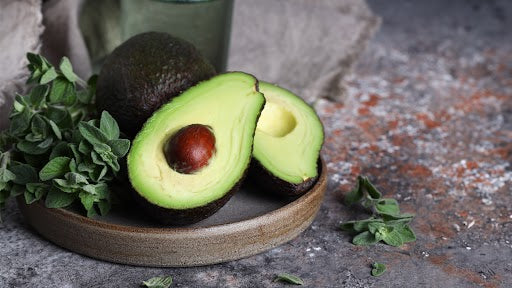
Avocado Oil For Babies: Gentle Benefits Of Nourishing Oil
Avocado oil has been a part of your kitchen for so long now it is becoming a part of your skincare routine. Known for its nourishing and hydrating properties, it is rich in vitamins, antioxidants, and healthy fats that works really well for your baby’s delicate skin.
When it comes to your baby, you naturally seek products that are as pure and gentle as possible. For centuries, the wisdom of Ayurveda has highlighted the importance of natural oils to promote a baby's wellness, believing that nature holds the key to soothing, protecting, and nourishing your baby's skin.
What is Avocado Oil?
Unlike many other essential oils, Avocado oil is not made from the seeds but extracted from the pulp of Avocado. It is enriched with antioxidants and moisturizing oil, known for its luxurious feel, and subtle scent. It is packed with nutrients that make it an ideal choice for your baby's delicate skin.
Avocado oil composition aligns beautifully with Ayurveda, which emphasizes natural ingredients that nourish and balance the body's doshas ( energy types). It has grounding and hydrating properties that make it suitable for your little one's skin, whose skin tends to be more vulnerable to dryness and irritation.
Nutrients in Avocado Oil
Vitamin E
Power pack of antioxidants that is essential for skin health. Vitamin E present in Avocado oil helps protect and soothe your baby's delicate skin against dryness and flakiness.
Essential fatty acids
Avocado oil is rich in healthy fatty acids, like oleic acids, which are known for their deep moisturizing properties. These fatty acids help strengthen the skin barrier by locking in moisture. For babies with naturally dry or sensitive skin, fatty acids offer gentle and lasting hydration.
Vitamin D and Beta carotene
These nutrients are also present in avocado oil in small amounts. While vitamin D is known for its properties like promoting skin health, beta carotene, is a precursor to vitamin A, offers skin-calming effects.
Benefits of Avocado oil for Babies

Here are some of the avocado oil benefits that make it an outstanding natural ingredient for supporting and protecting your baby’s delicate skin.
Hypoallergenic and Gentle
Avocado oil is known for its mildness, making it a good choice for the sensitive skin of your baby. Babies are prone to redness, and irritation due to their skin's delicacy. The gentle composition of avocado oil is less likely to cause discomfort to your baby.
Intensive Moisturizing Properties
Avocado oil for baby massage, It has the ability to deeply moisturize without feeling heavy or greasy. The fatty acids in the oil penetrate the skin easily, providing extra hydration.
Soothing Properties
Avocado oil's naturally soothing compounds, such as vitamin E and lecithin are perfect for calming skin discomforts like diaper rashes. Avocado oil for baby can help provide relief and restore skin texture.
How to use avocado oil safely for Babies
Avocado oil is incredibly versatile and can be used in several ways to care for a baby’s skin, from daily moisturizing routines to soothing specific problem areas.
Massage oil
Warm a small amount of avocado-infused baby body oil. Gentle massages are a great way to bond with your baby. You can give a body massage to your baby twice a day. Massaging before bedtime can help your baby relax and unwind.
Bath Additive
Just add a few drops of avocado oil in warm water for your baby’s bath. It will help in providing extra hydration to your baby’s delicate skin.
Diaper Rash Relief
Avocado oil has a cream texture that helps in nourishing your little one’s delicate skin. It also helps prevent diaper rashes and combat dryness.
Conclusion
You can incorporate Avocado oil into your baby's daily care routine. It will provide so many extra benefits like nourishment and hydration to your baby’s skin. This is a natural, safe, and effective ingredient to add to your baby’s daily care routine.

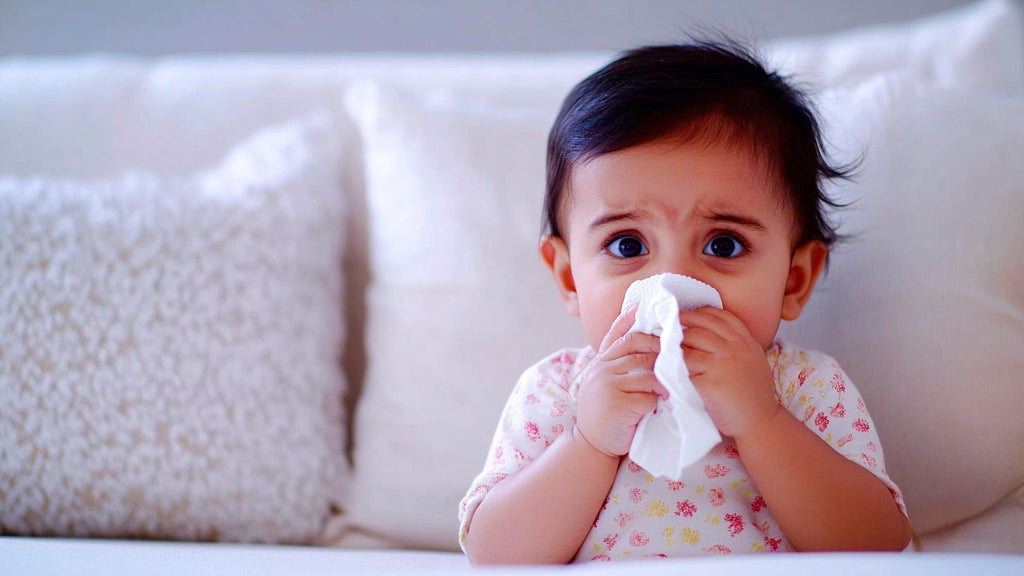
Why Is My Baby Sneezing So Much? Understanding Newborn Co...
If you’ve noticed your baby sneezing more than usual, it’s natural to feel a little worried. Is it a cold? Allergies? Or something else entirely? The good news is that sneezing in newborns is usually harmless and often a sign of their tiny bodies adjusting to the world around them. However, understanding why it happens and how to manage congestion can help you ensure your baby stays comfortable and healthy.
In this blog, we’ll explore the common reasons behind newborn sneezing and congestion, when to be concerned, and some simple ways to help your baby breathe easier.
Why Do Newborns Sneeze?
Newborn sneezing is a natural reflex that helps keep their nasal passages clear. Unlike adults, babies can’t blow their noses, so sneezing is their way of removing irritants like dust, milk, or mucus. Here are some common reasons your baby might be sneezing:
-
Adjusting to Air Quality
After spending nine months in the womb, your baby’s respiratory system is getting used to breathing air. Dust, pet dander, or even strong fragrances can cause sneezing as their tiny noses adapt to their new environment.
-
Clearing Mucus
Babies often have extra mucus in their nasal passages, especially in the first few weeks. Sneezing helps expel this mucus, keeping their airways clear.
-
Small Nasal Passages
A newborn’s nose is tiny, and even a little bit of congestion can make them sneeze more frequently.
-
Breast Milk or Formula Residue
Sometimes, milk can accidentally get into a baby’s nasal passages during feeding. Sneezing helps them clear it out.
-
Common Cold
If sneezing is accompanied by a runny nose, mild fever, or cough, your baby might have a common cold. Babies are more prone to colds since their immune systems are still developing.
What Causes Newborn Congestion?
Congestion in babies happens when their nasal passages are blocked or inflamed, making it harder for them to breathe. Here are some common causes:
-
Dry Air
During winter or in air-conditioned rooms, the air can become too dry, irritating your baby’s nasal passages.
-
Environmental Allergens
Dust, pollen, or smoke can irritate your baby’s sensitive nose and lead to congestion.
-
Teething
While teething, babies produce extra saliva, which can sometimes cause nasal congestion.
-
Infections
Viral infections like colds or mild respiratory illnesses can cause a stuffy or runny nose.
How to Identify If Your Baby Is Congested
Congestion in babies can make simple activities like feeding and sleeping a challenge. One of the common signs is snorting or noisy breathing, where you might notice a faint whistle or noise as your baby breathes. Congestion can also lead to difficulty in feeding, as a blocked nose makes it hard for your baby to nurse or drink from a bottle comfortably. Additionally, a congested baby may appear restless or fussy, especially during bedtime when lying flat can make congestion worse. You might also observe nasal discharge, either clear or thick mucus, which is another indication of nasal blockage. Recognizing these signs early can help you address your baby’s discomfort effectively.
Tips to Relieve Newborn Congestion
Congestion in newborns can often be managed with simple home remedies. Here are a few tips to help your baby breathe easier:
-
Use a Saline Nasal Spray
A saline spray is a safe and gentle way to loosen mucus in your baby’s nose. A couple of drops in each nostril can make a big difference.
-
Try a Bulb Syringe or Nasal Aspirator
These tools help remove mucus from your baby’s nose. Be gentle and only use them when necessary to avoid irritating their nasal passages.
-
Use a Humidifier
Adding moisture to the air with a humidifier can help relieve nasal dryness and congestion. Place it in your baby’s room, especially during winter months or if you use air conditioning.
-
Elevate Their Head Slightly
If your baby has trouble sleeping due to congestion, gently elevate the head of the crib mattress by placing a rolled towel underneath. Ensure it’s done safely to prevent any risk of rolling.
-
Use Baby Vapor Rub
For mild colds or stuffiness, a baby vapour rub like Baby Forest’s Komal Shwaas Vapor Rub can work wonders. This natural, gentle product contains soothing ingredients like eucalyptus oil, rosemary oil, and lavender oil. To use it, take a small amount on your fingers and gently rub it onto your baby’s chest, back, and the bottoms of their feet.This helps relieve congestion and makes breathing easier.

-
The Environment Clean
Reduce exposure to dust, smoke, and other allergens. Vacuum and clean regularly, and avoid using strong perfumes or sprays around your baby.
Conclusion
Sneezing and congestion can seem concerning, but they’re often just small bumps on the road of your baby’s growth. Understanding why your baby sneezes and how to handle congestion helps you care for them with confidence and ease.
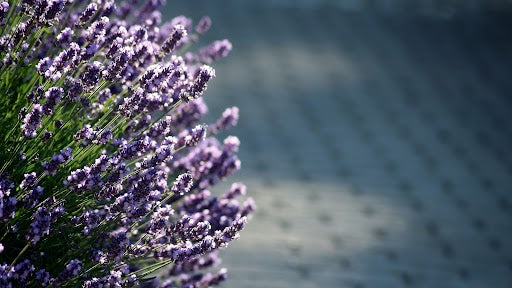
Exploring the Benefits of Lavender Oil for Babies
Lavender, known for its pale color and fragrance, is more than just a beautiful flower. Its oil is used in natural remedies and wellness products. But did you know it also can be used in baby care products? Lavender oil has antibacterial and therapeutic properties that can benefit your baby’s body and mind. Ayurvedic practitioners have been using lavender oil for quite a long time now.
Let's explore how lavender oil can support your baby’s well-being.
Origin of Lavender Oil
The Lavender plant is a member of the mint family. Originally harvested, lavender was later cultivated. It is used in herbal medicine. The name lavender derives from the Latin root “lavare,” which means “to wash.” Lavender oil is extracted from fresh flowers of the lavender plant through a process called distillation. In many regions, lavender flowers are believed to have the power to calm and purify the body and mind.
Benefits of lavender oil in Baby Care

Lavender oil, when used properly can benefit your baby in several ways:
Calming and Soothing Properties
As winters can be harsh on your baby, they might develop nasal congestion. Which can make them really uncomfortable and it is difficult to see them like this. Baby Vapour Rub containing lavender oil can be a gentle and effective way to help relieve this discomfort.
Provide Relief from Colic
Massage can be a great bonding time for you and your baby. Use lavender-infused body massage oil to give your baby a soft massage. This will help in releasing the trapped gas from your baby’s tummy and provide relief from problems like colic and more.
Natural Antibacterial Properties
Lavender oil has a calming fragrance that everyone likes. It also has antibacterial properties making it a natural ingredient in baby- safe floor cleaner, ensuring a clean and calming environment for your baby.
Acts as a Natural Barrier
Lavender oil for babies can help maintain the skin barrier by preventing moisture loss and supporting the natural defenses. Lavender oil-infused mosquito repellents can keep them at bay while being gentle on your baby's soft skin.
Mood-Boosting Properties
Lavender’s mood-boosting properties are largely due to its ability to reduce tension and anxiety. Babies can sometimes feel overstimulated or anxious due to new experiences, and lavender’s gentle aroma can soothe babies, helping them to feel more secure and reduce fussiness.
How to Use Lavender-Based Baby Products
Although Lavender has so many benefits, you must follow safe usage practices while incorporating lavender oil into your baby’s daily routine.
-
Choose Baby-Specific Products
Always select products that are formulated specifically for babies, as they are made with specific guidelines making them an ideal choice. -
Perform a Patch Test
It is recommended to do a patch test before applying any product to your baby's skin. A product with a higher concentration can cause redness, itching, or irritation. Perform a patch test on a small area of the baby's skin to check for any reaction. -
Follow Instructions
Read product labels carefully and use them as directed. Avoid applying the product near the baby’s eyes or mouth. -
Consult your pediatrician
Before using any new product for your baby always consult your pediatrician. As they can provide you with the best guidelines.

Conclusion
Lavender oil, when used thoughtfully, brings a natural and calming touch to your baby's daily care routine. By choosing the right products and following safe usage practices, you can help provide comfort, peace, and well-being for your little one.
Remember that simplicity, safety, and care will always lead to the most gentle and nurturing experiences for your baby.

Top Tips for Choosing the Safest and Most Comfortable Bab...
A baby cot is more than just a piece of furniture—it's a haven where your baby will spend a significant amount of time sleeping, resting, and growing. Choosing the right cot can feel overwhelming with so many options available, but focusing on safety and comfort will help you make the best decision.
Here are some practical tips to guide you in selecting the safest and most comfortable baby cot for your precious one.
-
Prioritize Safety Standards
When it comes to baby furniture, safety is non-negotiable. So firstly, we see to it that the baby cot meets established safety standards.Sturdy Frame:
The cot should feel stable and not wobble when gently pushed. A durable frame minimizes the risk of accidents.Safe Gaps Between Slats:
Ensure the gaps between the slats are less than 6 cm to prevent the baby’s arms, legs, or head from getting stuck.Rounded Edges:
The cot should have smooth, rounded edges to avoid injuries. No sharp corners or exposed nails!
-
Choose Leak-Proof and Easy-to-Clean Materials
Babies are messy; it's just part of their charm! A leak-proof cot mattress and easy-to-clean materials can save you a lot of hassle.
Look for cots with water-resistant mattresses or covers that can be wiped clean easily. These are great for unexpected spills, diaper leaks, or baby drool.
Avoid materials that stain easily or require complicated cleaning procedures. Remember, convenience is key when dealing with babies. -
Go for Adjustable Height Features
An adjustable height cot is a lifesaver for parents. It grows with your baby and ensures that the cot remains practical as your little one transitions from newborn to toddler.Newborn Stage:
A higher mattress setting allows you to place your baby in the cot without bending too much, saving your back.Toddler Stage:
As your baby becomes more active, a lower mattress setting ensures they can’t climb out and risk falling.
This flexibility makes adjustable cots a great long-term investment. -
Opt for Natural and Non-Toxic Materials
Babies are sensitive, and their skin can react to harsh chemicals. Choosing a cot made from natural and non-toxic materials is essential for their safety and comfort.Natural Wood:
Look for cots made from solid wood like teak, pine, or rubberwood. They’re not only durable but also free from harmful chemicals.Non-Toxic Paints and Finishes:
Ensure the paint and finishes used on the cot are lead-free and safe for babies, as they might chew on the cot rails when teething.Eco-Friendly Options:
If sustainability is important to you, explore eco-friendly baby cots made from renewable materials. -
Check for Durability and Longevity
A good baby cot should last for years, possibly even for multiple children. Investing in a durable cot makes sure you don’t have to replace it too soon.
Choose cots with a solid construction that can handle the wear and tear of daily use. Avoid lightweight, flimsy materials. -
Pay Attention to Comfort
Your baby’s comfort is just as important as their safety. A comfortable cot encourages better sleep, which is crucial for their development.Firm Mattress:
Opt for a firm and supportive mattress that fits snugly into the cot without any gaps. A well-fitting mattress prevents the baby from slipping into gaps, reducing the risk of injury.Breathable Bedding:
Use lightweight, breathable bedding like cotton sheets to keep your baby comfortable without overheating.Soft Edging:
While the mattress should be firm, soft edges around the cot can enhance comfort and prevent bumps. -
Cot Size
Consider the size of the cot and how it fits into your living space.Standard vs. Compact Size:
A standard-size cot offers more room for the baby to grow, while a compact cot is ideal for smaller spaces or for travel. -
Style and Design
While safety and comfort are priorities, there’s no harm in choosing a cot that complements your home’s décor. Baby cots come in various styles, from classic wooden designs to modern minimalistic ones. Opt for timeless colours like white, beige, or natural wood tones. They blend well with most interiors and never go out of style.
Final Thoughts
Choosing the right baby cot is a big step. Think of it as creating your baby’s first little world—a cozy, safe space where they can sleep, dream, and grow. Take your time while shopping. Read reviews, ask questions, and don’t rush into a decision. The good news is, you don’t have to sacrifice style for practicality—there are plenty of beautiful cots that meet all your needs.
The Baby Forest Kilkari Wooden Baby Cot is a wonderful example of blending safety, comfort, and style. Made from high-quality HDMR wood and natural cane, this cot is thoughtfully designed with eco-friendly materials to ensure a safe, non-toxic space for your little one. The chemical-free, natural paint not only looks beautiful but also prioritizes your baby’s health and well-being. Plus, it comes with a comfortable mattress that features a leak-proof cover—perfect for keeping things clean and cozy.
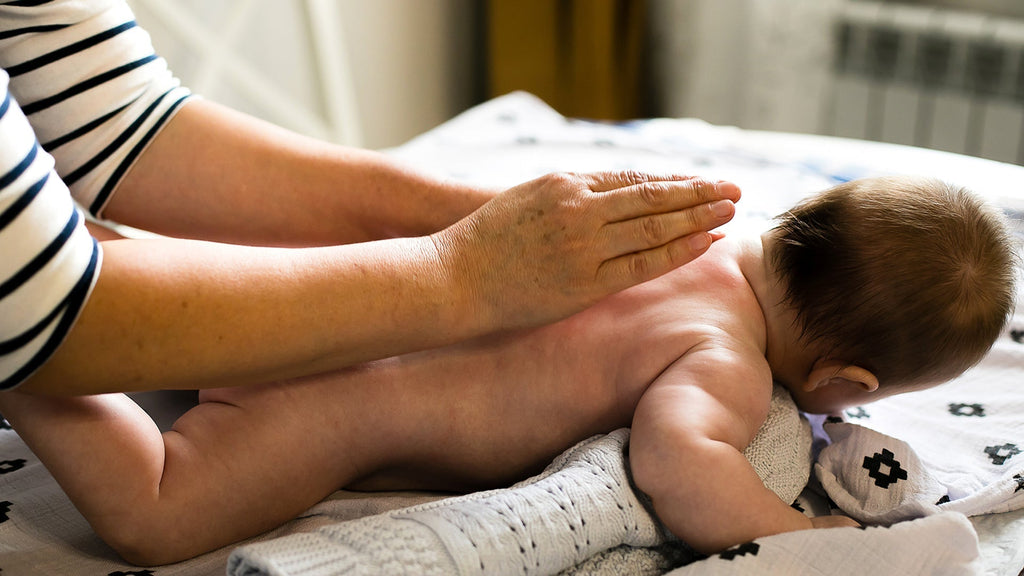
How to Create a Simple Baby Skincare Routine this Winter
Winter can give your baby’s delicate skin a hard time. The cold weather, low humidity, and indoor heating can easily dry out their skin, leaving it rough, irritating, and uncomfortable. Just like adults, babies need a little extra care during this season to keep their skin soft, hydrated, and healthy. Creating a simple baby skincare routine in winter isn’t difficult, but it requires the right products and consistency.
Effective baby skincare step-by-step guide

Step 1: Gentle Baby Massage Oil
A warm oil massage is a fantastic way to start your baby’s day, especially in the winter. Massaging your baby helps improve circulation and keeps their skin moisturized. Choose a natural massage oil that is rich in nutrients and can deeply nourish your baby’s skin.
Look for oils like coconut oil, or almond oil, which are perfect for retaining moisture and protecting against the dryness that winter can bring. Gently warm the oil by rubbing it between your hands and give your baby a relaxing massage for 10-15 minutes before bath time. This also preps the skin for cleansing while ensuring it stays moisturized.
Step 2: Mild Baby Shampoo
During winter, your baby’s scalp can also become dry, and using the right baby shampoo is important to prevent irritation or flakiness. Go for a mild, tear-free shampoo made specifically for babies that don’t strip away natural oils.
Shampoo your baby’s hair gently using lukewarm water, massaging the scalp with your fingertips. Don’t shampoo too often; 2-3 times a week is usually sufficient in winter. This will help maintain the natural oils in your baby’s scalp, keeping it healthy and moisturized.
Step 3: Baby Body Wash
While giving your baby a bath, it is essential to choose a baby body wash that hydrates the skin rather than drying it out. Look for products that are free from harsh chemicals and contain natural, moisturizing ingredients like aloe vera or oat extracts.
Make sure the water is warm, not hot, as hot water can dry out your baby’s skin further. Use the body wash to gently cleanse your baby’s body, focusing on the folds of their skin where moisture loss can be more intense. A quick bath is all your baby needs in winter to avoid stripping their skin of essential oils.
Step 4: Kids Face Wash
Babies often drool or rub their faces, and in winter, this can make their delicate skin even more prone to dryness. A mild kids' face wash is a great addition to your winter skincare routine, ensuring that your baby’s face is clean without being stripped of moisture.
A gentle face wash formulated specifically for children helps remove dirt and impurities, leaving your baby’s face soft and smooth. Make sure you wash your baby’s face with lukewarm water and pat it dry with a soft towel.
Step 5: Rose Water Mist
After cleansing your baby’s skin, especially their face, applying a light mist of rose water can provide extra hydration and soothe any irritation. Rose water is known for its calming properties and helps to lock in moisture, making it a great option to include in a winter skincare routine.
Spritz a bit of rose water mist on your baby’s face and gently pat it in. This step can be particularly helpful if your baby’s skin is sensitive or prone to redness during the colder months.
Step 6: Baby Face Cream
In winter, your baby’s face is often more exposed to the cold air, making it essential to apply a baby face cream that offers deep hydration. Choose a cream that contains natural ingredients like shea butter or almond oil, which provide long-lasting moisture and protect the skin from dryness.
Apply a small amount of face cream after using the rose water mist. Gently massage it into your baby’s face, focusing on areas that tend to get dry, like the cheeks, chin, and forehead. This will help prevent chapped or flaky skin, keeping your baby’s face soft and smooth all day long.
Step 7: Baby Body Lotion
Once your baby’s bath is done, the next important step is locking in all the moisture with a nourishing baby body lotion. Winter can rob your baby’s skin of its natural moisture, so it’s crucial to use a lotion that hydrates deeply and lasts throughout the day.
Look for lotions with ingredients like cocoa butter, shea butter, or aloe vera, which are known for their moisturizing properties. After gently patting your baby dry with a soft towel, apply the lotion all over their body, paying extra attention to areas prone to dryness, such as the elbows, knees, and feet. This will ensure that your baby’s skin stays hydrated and soft throughout the day.
Conclusion
Winter can be tough on your baby’s skin, but with a thoughtful routine and the right products, you can easily protect and nourish it. By keeping their skincare simple and effective, you’re ensuring that their skin stays soft, healthy, and happy, no matter how cold it gets outside.

How to Use Baby Vapour Rub for Cough Relief
When your baby has a cough, it can be distressing for both you and your little one. Babies, especially newborns, have delicate immune systems, which means even the smallest cold or cough can leave them feeling uncomfortable. As parents, we're always looking for safe and effective ways to bring relief to our babies, and one popular remedy is using baby vapour rub.
Vapour rubs are known to help ease congestion, clear stuffy noses, and provide relief from coughing. However, knowing how to use them correctly and safely is essential, especially for young infants. In this blog, we'll walk you through the benefits of using vapour rub for babies and share tips on how to use it effectively to provide relief from coughs and colds.
What is a Baby Vapour Rub?
Vapour rub is a soothing ointment that works by releasing comforting vapours from natural oils like eucalyptus and rosemary to help relieve congestion. When your baby is dealing with a stuffy nose or cough, these vapours open up the nasal passages, making it easier for them to breathe. This is especially helpful at bedtime when coughing can get worse, and sleep becomes difficult. Plus, many baby vapour rubs contain calming oils like lavender and thyme, which can help your little one relax and sleep better.
However, it's important to choose a vapour rub that's specifically made for babies. Regular vapour rubs, designed for adults, often have stronger ingredients that might be too harsh for your baby's sensitive skin and respiratory system. Baby vapour rubs are made with gentler, natural ingredients that are safe for your little one, giving them relief without any risks. So, always check the label to ensure it is baby-friendly!
How Does Vapour Rub Work?
When you apply vapour rub to your baby's chest, back, or feet, the warmth from their body helps release the soothing vapours into the air. These vapours are then inhaled, which helps to reduce nasal congestion and ease coughing. Some vapour rubs also contain essential oils that are absorbed through the skin, providing a calming and relaxing effect.
It's a popular remedy because it's non-invasive and doesn't require your baby to ingest anything, making it ideal for babies who are too young for over-the-counter medications. Vapour rub provides an effective way to support your baby's breathing while they're fighting off a cold or cough.
Tips for Using Baby Vapour Rub Safely
While vapour rub is generally safe for babies, it's important to follow a few precautions to make sure your baby gets the most benefit without any risks.
-
Check the age recommendations:
Always check the label to see to it that the vapour rub is suitable for your baby's age. Some products are designed specifically for babies over 3 months, while others may be safe from birth.
-
Do a patch test:
Babies have sensitive skin, so it's a good idea to do a patch test before applying vapour rub all over. Apply a small amount on your baby's forearm and wait for 24 hours to check for any allergic reactions or skin irritation.
-
Avoid applying near the nose or eyes:
Never apply vapour rub directly under your baby's nose or near their eyes, as the strong vapours can irritate these sensitive areas. Instead, focus on the chest, back, and bottoms of their feet.
-
Apply before bedtime:
Vapour rub works best when applied just before bedtime, as it helps to open up airways and provide comfort throughout the night.
How to Use Baby Vapour Rub for Cough Relief
Now that you know how vapour rub works, here's a step-by-step guide on how to use it effectively for your baby's cough relief:
-
Step 1:
Take a small, adequate amount of vapour rub on your fingertips.
-
Step 2:
Gently massage it onto your baby's chest, back, and bottom of their feet. You can also apply a small amount on their forehead.
-
Step 3:
Make sure the area is covered with light clothing to keep your baby warm and allow the vapours to work their magic.
-
Step 4:
For older babies (over 6 months), you can use a warm towel to cover the chest after applying the vapour rub for added comfort.
-
Step 5:
Reapply the vapour rub whenever necessary, especially before naps or bedtime.
Choosing the Right Vapour Rub
When choosing a vapour rub for your baby, it's important to go for a product made with natural, safe ingredients. One such option is the Baby Forest Komal Shwaas Vapour Rub, which is specifically designed for babies. It contains a blend of natural oils, such as eucalyptus oil, lavender oil, and rosemary oil, which are known for their soothing and congestion-relieving properties.
To use Baby Forest Komal Shwaas Vapour Rub, simply take an adequate amount on your fingers and apply it gently to your baby's chest, nose, forehead, and the bottom of their feet. Its gentle, natural ingredients like beeswax, coconut oil, and sesame oil make it perfect for your baby's sensitive skin, while the combination of essential oils helps calm the cough and open up the airways.
What's more, this vapour rub is free from parabens and is Ayush-certified, ensuring it's safe for your little one. The derma-safe formula means it's unlikely to cause irritation, and it provides a natural, non-invasive way to ease cough symptoms in your baby.
Additional Ways to Ease Your Baby's Cough
While vapour rub can be very effective, there are a few additional things you can do to make your baby more comfortable when they have a cough:
-
Use a humidifier:
Adding moisture to the air can help soothe your baby's irritated throat and loosen mucus, making it easier for them to breathe.
-
Elevate your baby's head:
If your baby has a stuffy nose or cough, gently elevate their head with a pillow (for older babies) or place a towel under the mattress for younger infants to help reduce congestion.
-
Offer plenty of fluids:
Keeping your baby hydrated is essential when they're not feeling well. If your baby is breastfeeding or formula-feeding, offer feeds more frequently.
-
Give them a warm bath:
A warm bath can help ease congestion and soothe your baby. The steam from the water helps open up their nasal passages, providing relief.
Conclusion
Using vapour rub is just one of the many ways to comfort your baby during a cough. However, it's important to remember that every baby is different. Some may respond quickly to vapour rub, while others might need additional care such as a humidifier or warm baths. The key is to create a comforting and soothing environment that helps your baby feel relaxed and secure.

Here Are The Best Ways to Treat Diaper Rashes: Home Remedies
Is your baby fussy and uncomfortable because of those itchy diaper rashes? Moms are always extra careful with their baby's sensitive skin, but even the best diapers might not always prevent rashes. Almost every baby experiences diaper rashes during their first year. The good news is that with the right care and products, you can treat and prevent diaper rashes effectively.
Is It Diaper Rash or a Yeast Infection?
It's important to know whether your baby has a simple diaper rash or a more serious yeast infection, as both require different treatments. So, how do you tell the difference?
- Diaper Rash: If the rash is slightly red, dry, and not oozy or painful, it's most likely a diaper rash. With the right diaper rash treatment, it should clear up in just a couple of days.
- Yeast Infection: If the patches are located in the folds of the skin or groin area and are oozy, bumpy, or bleeding, it might be a yeast infection. In severe cases, your baby may also develop a fever. A yeast infection can take a few weeks to clear and may need prescription medicines.
Understanding this distinction is key to giving your baby the right care, whether it's home remedies or a prescribed solution.
What Causes Diaper Rashes?
There are several common causes of diaper rashes. Understanding these can help you take the right preventive steps.

Skin Reactions
Babies have extremely sensitive skin, and products like detergents, soaps, creams, and even diapers can cause reactions. Many of these products contain chemicals like boric acid, benzocaine, and salicylates, which are harmful to babies and can lead to diaper rashes.
Solution: Always opt for natural, chemical-free products. For instance, Baby Forest's Mridul Poshaak Liquid Detergent, Nirmalya Snan Natural Baby Soap, and Sampoorna Snan Baby Body Wash are gentle on your baby's skin and help prevent irritation.
Dryness
Babies' skin is more prone to dryness, especially with the frequent use of diapers and wipes. Dry skin can become inflamed, leading to severe rashes if not treated properly.
Solution: Keep your baby's skin hydrated by regularly applying a gentle moisturizer, such as Baby Forest's Moh Malai Baby Body Lotion. It helps lock in moisture and keeps their skin soft and smooth.
Antibiotic and Citrus Intake
If your baby is taking antibiotics, either directly or through breast milk, it can upset the balance of good bacteria and lead to diaper rashes. Similarly, citrus fruits or acidic foods like tomato sauce can irritate the skin, especially around the diaper area.
Solution: Avoid giving your baby citrus foods until their skin has healed, and if they're on antibiotics, monitor for any signs of rashes.
Friction and Infection
Tight diapers that rub against the skin can cause irritation, leading to diaper rashes. It's important to ensure the diaper fits properly, leaving enough room for air to circulate.
Solution: Make sure the diaper is spacious enough to allow you to fit your hand between the diaper and your baby's belly. This helps reduce friction and allows the skin to breathe.
Home Remedies for Diaper Rash
While there are many creams and products available, some simple home remedies for diaper rash can also be effective. Here are a few you can try:
- Coconut Oil: It acts as a natural moisturizer and has antibacterial properties, which can help soothe irritated skin.
- Aloe Vera Gel: Applying aloe vera gel to the affected area can relieve itching and promote healing.
- Breast Milk: Some mothers find that applying a little breast milk to the rash can help soothe it due to its natural antibodies.
Remember, if the rash doesn't improve after a few days of trying home remedies, consult your doctor.
Which Cream Is Best for Diaper Rashes?
There are countless creams available, but the best diaper rash cream should heal the skin naturally and protect it from further irritation. Baby Forest's Komal Kawach Rash Healing Cream is an Ayurvedic solution that's ideal for treating red, itchy rashes.
Infused with natural coolants like vetiver and moisturizing ingredients such as aloe vera and vitamin E, it forms a protective shield on the skin, preventing infection. For parents seeking a more natural alternative, this rash healing cream is a great choice.
Final Thoughts
Diaper rashes are common, but with the right diaper rash solution, your baby can be comfortable and rash-free. Whether you're opting for natural remedies, choosing the best diaper rash cream, or being cautious with the products that touch your baby's skin, the goal is the same: to keep your baby happy, healthy, and comfortable.
By understanding the causes and knowing the right treatments, you can help your baby avoid the discomfort of diaper rashes and enjoy the benefits of smooth, healthy skin.
Reference Link: Helpful Tips for Diaper Rash: What You Need to Know

How to Perform an Abhyanga Massage for Babies
Massaging your baby is not just a way to relax and bond; it’s a time-honored tradition that has been passed down through generations in India. Known as Abhyanga, this Ayurvedic practice involves the gentle application of warm oil all over the body. Abhyanga massages offer several benefits, including promoting healthy skin, improving circulation, and helping babies sleep better.
For new parents, performing an Abhyanga massage might feel intimidating at first, but with a little practice and patience, it can become a calming routine that both you and your baby look forward to. In this blog, we’ll walk through how to perform an Abhyanga massage for your baby step by step while also explaining the numerous benefits this practice provides.
What is Abhyanga Massage?
Abhyanga is a form of Ayurvedic massage that involves applying warm oil to the skin in long, gentle strokes. Traditionally, oils like sesame oil, coconut oil, or almond oil are used, each offering its own unique benefits. In babies, Abhyanga helps improve skin texture, promotes better blood flow, and can even soothe a fussy child, helping them to relax and sleep more soundly.
In Ayurveda, it is believed that regular oil massages help in balancing the doshas (Vata, Pitta, and Kapha) in the body, which is important for overall well-being. For babies, it also strengthens the immune system and supports their physical development.
Benefits of Abhyanga Massage for Babies
Before we explain how to give an Abhyanga massage, let’s look at why it’s so beneficial for your baby:
-
Improves Circulation:
The gentle strokes during the massage help boost blood flow, which is essential for healthy growth and development.
-
Promotes Relaxation:
A good massage helps soothe your baby’s nervous system, calming them down and making them feel secure.
-
Aids Digestion:
Massaging the stomach area can help with gas, colic, and constipation.
-
Boosts Immune System:
Regular massages help stimulate the lymphatic system, which in turn strengthens the immune system.
-
Encourages Better Sleep:
The warmth of the oil and the rhythmic movements promote relaxation, which helps babies sleep more soundly.

Choosing the Right Oil for Abhyanga Massage
Selecting the right oil for your baby’s massage is an important step. Some of the most commonly used oils include:
-
Sesame Oil:
This is a classic Ayurvedic oil known for its warming properties. It’s especially good for babies born in colder months as it helps retain body heat.
-
Coconut Oil:
Known for its cooling and moisturizing properties, coconut oil is great for babies born during the summer or those with sensitive skin.
-
Almond Oil:
Almond oil is rich in vitamin E, which nourishes the skin and is suitable for all skin types.
-
Olive Oil:
Often used in many homes, olive oil is light and easily absorbed, making it ideal for regular use.
How to Perform an Abhyanga Massage for Your Baby
Now that you know why Abhyanga is so beneficial, let’s break down the steps of giving your baby a soothing and effective massage.
Step 1: Set Up a Comfortable Space
Find a quiet, warm place in your home where you and your baby can relax. Lay down a soft towel or blanket on a firm surface. Make sure the room is at a comfortable temperature, so your baby doesn’t get too cold.
Step 2: Warm the Oil
Pour a small amount of your abyanga oil into a bowl and gently warm it. You can do this by placing the bowl in hot water for a few minutes. Make sure the oil is comfortably warm, but not too hot, by testing it on the inside of your wrist.
Step 3: Start with the Legs
Begin the massage with your baby’s legs. Using your hands, apply the warm oil and gently stroke downwards from the thigh to the ankle. Use firm but gentle pressure and remember to massage both the front and back of the legs. This helps stimulate circulation and muscle development.
Step 4: Move to the Arms
Next, apply oil to your baby’s arms, starting from the shoulders and working your way down to the wrists. You can also massage their tiny hands by gently opening their palms and pressing lightly on each finger. This not only improves circulation but also enhances sensory development.
Step 5: Massage the Chest and Tummy
With gentle strokes, massage your baby’s chest. You can make small circular motions around the chest area, which can help open up the lungs and improve breathing. When massaging the tummy, use circular motions in a clockwise direction to aid digestion and reduce gas or colic.
Step 6: Back and Spine
Gently turn your baby over onto their tummy and apply oil to the back. Using your hands, move in long strokes from the neck down to the bottom of the spine. This is especially relaxing for your baby and helps with the development of their spinal muscles.
Step 7: Massage the Head and Face
Lastly, apply a small amount of oil to your baby’s scalp and massage gently with your fingertips. This promotes hair growth and calms your baby. For the face, use your fingers to gently stroke from the centre of the forehead outward, down the nose, and across the cheeks.
Step 8: Finish with the Feet
Babies love having their feet massaged! Use your thumbs to press lightly on the soles of your feet in circular motions. This helps improve circulation and stimulates the nerve endings in the feet, promoting overall well-being.
Baby Forest’s Shishu Abhyanga Oils
For parents seeking a natural, safe, and effective oil for their baby’s Abhyanga massage, Baby Forest’s Shishu Abhyanga Oils is a fantastic option. This all-in-one oil combo set is designed to provide the perfect oils for your baby’s body and hair massage needs. The combo includes:
-
Maasoom Malish Baby Body Massage Oil:
A gentle body massage oil that nourishes and hydrates your baby’s skin, perfect for daily use.
-
Nanhi Champi Baby Hair Massage Oil:
This oil promotes healthy hair growth and strengthens the scalp, making it ideal for regular head massages.
-
Badami Sneh Organic Almond Cold Pressed Oil:
Rich in vitamin E, this oil deeply nourishes your baby’s skin, leaving it soft and smooth.
-
Narial Tailam Organic Cold Pressed Coconut Oil:
Known for its cooling and moisturizing properties, this coconut oil is perfect for keeping your baby’s skin hydrated, especially during warmer months.
What makes the Shishu Abhyanga Oils even more special is the addition of a complimentary surprise gift—a delightful toy or a handy travel kit, making the set a complete package for your baby’s care routine.
To use these oils, simply warm a small amount in your hands and apply it gently to your baby’s body or hair, following the steps outlined for an Abhyanga massage. The nourishing blend of natural oils will help relax your baby, improve their skin and hair health, and promote restful sleep, making it an essential part of your baby’s daily care routine.
When Should You Do Abhyanga?
Abhyanga can be done daily, preferably before bath time. Some parents like to do it in the morning, while others prefer a gentle massage before bedtime to help their baby sleep. Whatever time you choose, try to be consistent so your baby begins to recognize the routine and feel secure.
Conclusion
As you incorporate Abhyanga into your baby’s daily routine, you’re not only helping their body grow and develop but also nurturing their sense of security and love. So, take your time, enjoy the process, and know that with each gentle stroke, you’re supporting your baby’s health and happiness.

Common Skin Conditions in Babies: An Expert Guide for Par...
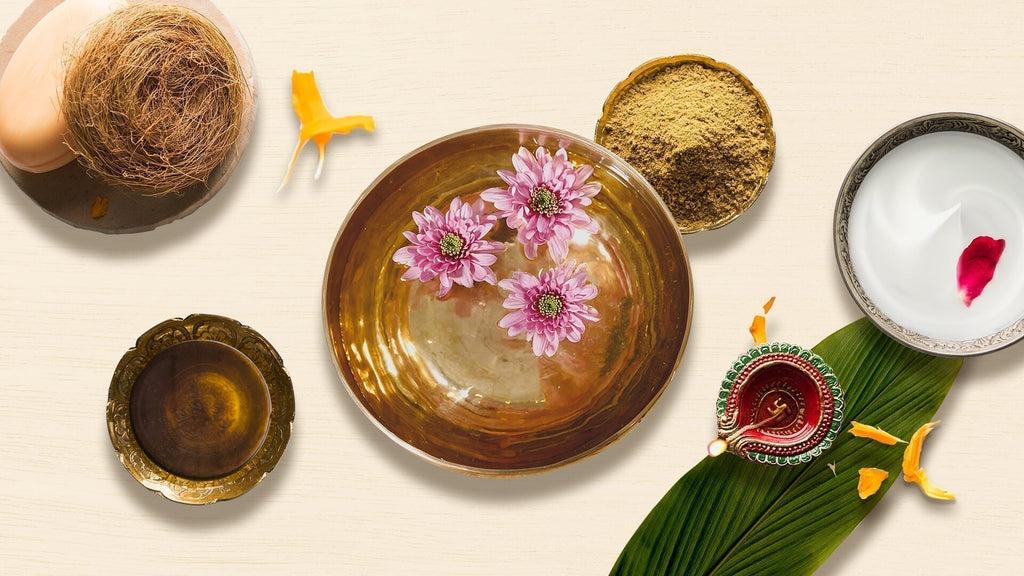
Baby Bath Ritual: An Essential Ritual for Baby’s Growth &...
Baby bath rituals in India are deeply rooted in the ancient holistic wellness concepts of Ayurveda and are intrinsic to mother and childcare. According to Ayurveda, bathing is a therapeutic, healing experience that restores physical energy, removes accumulated toxins, sweat, and dirt from the baby’s skin, and relaxes the mind by balancing emotions. While it may seem like a simple task, a baby bath ritual is packed with benefits that go beyond just cleanliness.
A baby’s first bath is considered one of the most nourishing, cleansing, and comforting experiences in their early life.
Benefits of Bathing a Baby Daily
Many parents wonder whether they should bathe their baby every day. The benefits of bathing a baby daily is numerous and go far beyond maintaining hygiene. Daily baths, especially at a fixed time, help relax the baby, restore their balance, and promote natural growth. Establishing this routine can make the baby feel more secure and comfortable.
-
Calms and Relaxes
Bathing has a calming effect on babies, which can help them sleep better, particularly if included as part of their bedtime routine.
-
Cleanses Skin Gently:
Daily bathing helps remove dirt, sweat, and accumulated oils, ensuring your baby’s skin stays fresh and healthy.
-
Promotes Circulation:
Bathing improves blood circulation, which helps the baby's muscles relax, fostering overall physical development.
How to Bathe a Newborn: A Step-by-Step Guide
Understanding the proper baby bath procedure is essential for new parents. Bathing a newborn may seem overwhelming, but following these steps can make the experience smooth and enjoyable.

Step 1: Warm Oil Massage Before Bath Time
According to Ayurveda, a warm oil body massage is essential for the baby as it controls aggravated Vata Dosha, emphasizing the belief that touch therapy creates a beautiful, deep bond between the mother and child. Before the bath, use gentle oils to massage the baby’s body, helping soothe their muscles and prepare them for the bath.
Baby Forest has formulated the Maasoom Maalish baby body massage oil with a blend of 10 Ayurvedic essential oils. These oils, derived from herbs, flowers, and medicinal plants, strengthen the baby’s blood vessels, improve blood circulation, and help in bone development.
Step 2: Gentle Cleanse During the Bath
According to Ayurvedic philosophy, a bath helps in eliminating stress, cleansing the skin, and soothing the nerves.
To ensure a gentle cleanse, use Baby Forest’s luxurious Sampoorna Snan Baby Body Wash. This product, enriched with Ayurvedic herbs and oils, keeps your baby’s delicate skin hydrated, maintains its natural moisture, and leaves it soft and supple.
Step 3: Deep Moisturizing After Bath
After a refreshing bath, it’s crucial to lock in moisture to prevent your baby’s skin from drying out. Apply the Moh Malai Baby body lotion, a lightweight, deeply hydrating cream enriched with Shea butter, Rose Petals, and Mulethi. It penetrates deeply into the skin, ensuring intense moisturization and nourishment.
Must Have Baby Hair Care Products
Many parents overlook the importance of caring for their baby’s hair. Just like skin, a baby’s hair requires gentle care and attention. Baby hair products that are mild and formulated for sensitive skin are crucial to ensure that the baby’s scalp stays clean and healthy.
-
Shampooing:
Use a mild baby shampoo that’s free from harsh chemicals. A gentle formula cleanses without stripping away the natural oils, keeping the scalp healthy.
-
Hair Oil:
For babies with a dry scalp, applying a small amount of baby hair oil can help keep their hair soft and manageable.
Baby Forest offers specially formulated baby hair care products that are gentle on the baby’s scalp and keep their hair healthy and shiny.

Creating a Soothing Bath Time Routine
The key to a successful baby bath procedure is making sure the environment is calm, and the baby feels secure. Here’s how to make the process even more soothing for your baby:
-
Use Soothing Music or Lullabies:
Playing soft music or singing to your baby during bath time can create a comforting atmosphere.
-
Introduce Bath Toys:
For older babies, adding toys to bath time can make the experience more engaging and fun.
-
Maintain Eye Contact and Smile:
A reassuring smile and gentle eye contact help your baby feel safe and loved during the bath.
Baby Bath Essentials: What You Need
Having the right products makes all the difference in ensuring a smooth, safe, and enjoyable bath time. Here’s a quick look at the must-have baby bath essentials:
|
Bath Essential |
Why You Need It |
|
Mild Baby Soap |
Gentle on your baby’s sensitive skin, cleanses without irritation. |
|
Soft Washcloth |
Perfect for cleaning those tiny folds and creases. |
|
Baby Bathtub |
Provides a safe, secure space for the baby to bathe. |
|
Hooded Baby Towel |
Keeps your baby cozy and warm right after the bath. |
|
Moisturizing Lotion |
Helps lock in moisture, protecting delicate skin from dryness. |
|
Water Thermometer |
Ensures the bathwater is at a safe, comfortable temperature. |
Conclusion
Incorporating a daily bath routine for your baby is not just about maintaining hygiene but also about promoting overall growth and wellness. With the right baby bath products, a gentle bath procedure, and some love and care, you’re ensuring that your baby enjoys both the physical and emotional benefits of this calming ritual.
Make bath time a bonding moment that relaxes your baby, supports their growth, and keeps them happy and healthy!
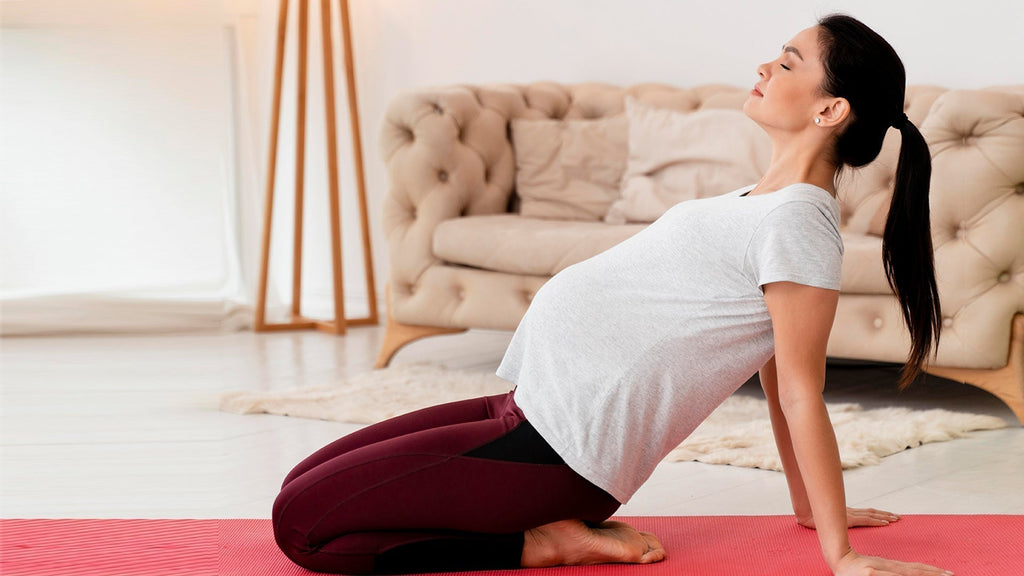
Prenatal Yoga and Its Benefits for Pregnant Women
Pregnancy is an amazing time, but let's be honest—it can also be pretty overwhelming. Between the backaches, swollen feet, and waves of emotions, your body is going through a lot. And as exciting as it is to feel your baby growing, the changes can sometimes leave you feeling tired and disconnected from yourself. Sound familiar?
That's where prenatal yoga comes in. Think of it as a gentle way to help your body adjust to pregnancy while also giving you a chance to relax and focus on yourself and your baby. Prenatal yoga isn't about twisting into impossible poses; it's designed especially for pregnant women, focusing on stretches and movements that help with all those pregnancy discomforts while keeping you calm and centered.
Let's explore the many benefits of prenatal yoga and why it's something every expecting mom should consider.
What is Prenatal Yoga?
Prenatal yoga is a type of yoga specifically designed for pregnant women to support their changing bodies and growing babies. It focuses on gentle stretches, breathing exercises, and relaxation techniques that are safe and beneficial during pregnancy. Unlike regular yoga, prenatal yoga avoids intense poses and focuses on movements that improve flexibility, strength, and balance, while also easing common pregnancy discomforts like back pain and swelling. Beyond the physical benefits, prenatal yoga helps moms-to-be stay emotionally balanced and calm, preparing both body and mind for labor and delivery.
Benefits of Prenatal Yoga:

Improves Flexibility and Strength
As your body grows and changes during pregnancy, it's natural to feel less flexible or stronger than usual. The growing baby puts extra strain on your muscles and joints, leading to discomfort in the back, hips, and legs. Prenatal yoga can help by gently stretching and strengthening the muscles you use most during pregnancy.
Yoga poses like cat-cow, warrior, and bridge pose are great for improving flexibility in your spine and hips, which can ease discomfort and help your body adjust to its new form. The strength gained through prenatal yoga also prepares your body for the physical demands of labour and delivery.
Reduces Pregnancy Discomfort
Aches and pains are part and parcel of pregnancy. Many women experience discomfort in their lower back, hips, and legs as their pregnancy progresses. Prenatal yoga can be an excellent way to alleviate some of this discomfort.
Gentle stretching and certain yoga poses help release tension in key areas of the body. For example, the cat-cow pose can ease back pain by stretching the spine, while the child's pose provides relief for your lower back and hips. Yoga can also improve circulation, which helps reduce swelling in your feet and ankles, a common complaint during the later stages of pregnancy.
Promotes Relaxation and Better Sleep
Pregnancy can sometimes lead to restless nights, especially as you get closer to your due date. It's not uncommon to feel anxious about the upcoming birth or simply uncomfortable with your changing body. Prenatal yoga is an effective way to manage stress and anxiety, helping you relax both mentally and physically.
Yoga incorporates deep breathing exercises, which are great for calming your mind and reducing tension. These breathing techniques are not only useful during your yoga sessions but can also help you relax before bedtime. This can result in better sleep quality, something every pregnant woman values.
Prepares You for Labor and Delivery
One of the most significant benefits of prenatal yoga is its ability to prepare your body for labour. Labour can be physically demanding, and being in tune with your body can make a big difference in how you manage contractions and pain.
In yoga, you learn to focus on your breathing, which can be incredibly helpful during labour. Controlled, deep breaths help you stay calm and relaxed, even when things get intense. Poses like squats and hip openers help strengthen the muscles you'll use during delivery while also improving flexibility in your pelvic area, which can make the birthing process smoother.
Encourages a Connection with Your Baby
Pregnancy is a time of great transformation, not just physically but emotionally. Prenatal yoga offers a space where you can slow down, breathe deeply, and connect with your growing baby. It's an opportunity to focus inward on the bond that's forming between you and your little one.
Many women find that the quiet moments during yoga, particularly during meditation or relaxation poses, allow them to truly tune into their bodies and feel more connected to their babies. This mindfulness can be a calming and grounding experience, helping you stay centered and focused during your pregnancy.
Builds a Supportive Community
Joining a prenatal yoga class isn't just good for your body and mind—it's also a great way to meet other pregnant women who are going through the same experience. Pregnancy can feel isolating at times, especially if you're dealing with challenges like nausea or fatigue, but being part of a yoga class can create a sense of community and support.
Having a group of women to share your journey with can provide emotional comfort, whether it's swapping tips, sharing stories, or simply having someone who understands what you're going through. Many moms-to-be form lasting friendships through prenatal yoga, making it an even more rewarding experience.
Conclusion
Prenatal yoga offers countless benefits, both physically and emotionally, for expecting mothers. But it's more than just a series of poses and breathing exercises—it's about making space for yourself and your baby during this unique time in your life. As you move through pregnancy, yoga can help you stay grounded, improve your physical health, and prepare for the incredible journey of motherhood.
One of the great things about prenatal yoga is that it can be adapted to your needs, whether you're just starting out or have been practising for a while. It's also a fantastic way to build a routine that you might carry into postpartum life, where gentle movement and mindfulness continue to play a big role in your well-being.
So, if you haven't tried it yet, consider giving prenatal yoga a go. Whether you join a class or practice at home, remember that this time is about nurturing both your body and mind. And who knows? You might find that it becomes a valuable part of your pregnancy journey and beyond!
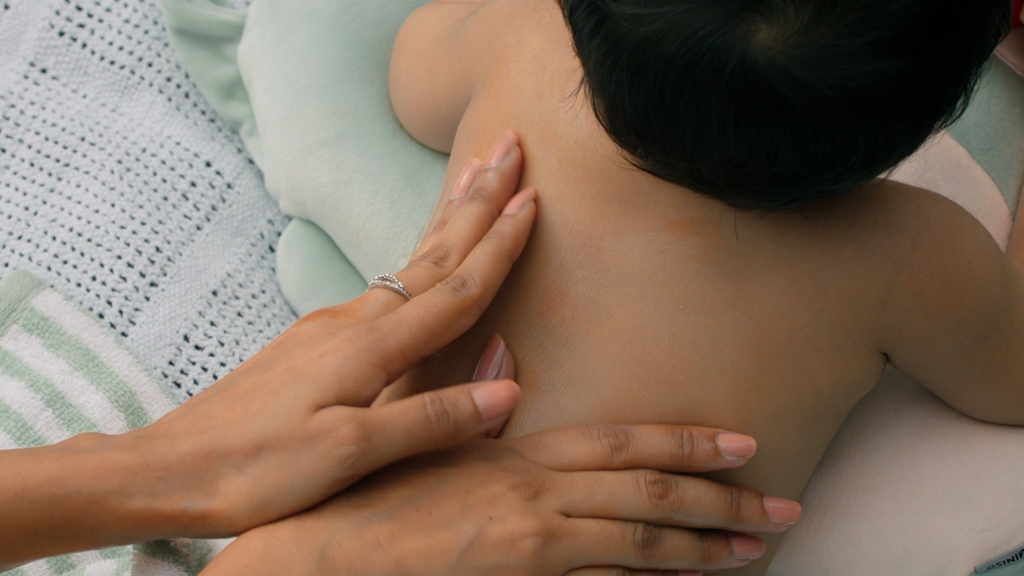
Essential Oils Benefits for Babies: A Complete Guide for ...
The arrival of a newborn is a beautiful and transformative experience that inspires you to seek the best ways to care for your precious bundle of joy.

Best Ways to Get Rid of Mosquitoes This Monsoon
Monsoon brings the refreshing smell of rain, cooler temperatures, and beautiful greenery. But along with all this goodness comes something not so pleasant – mosquitoes. These tiny pests are more than just annoying; they can also carry serious diseases like dengue, malaria, and chikungunya. And if you have infants or young kids at home, the concern is even greater. Keeping them safe from mosquito bites becomes a top priority. But don't worry! In this blog, we'll explore the best ways to get rid of mosquitoes this monsoon, focusing on safe and effective solutions for everyone, especially your little ones.

-
Use Natural Mosquito Repellents
One of the safest ways to protect your baby from mosquitoes is by using a mosquito repellent for infants that is free from harmful chemicals. Mosquito repellents come in various forms – sprays, creams, and patches. However, choosing the right one for your little one is crucial. Look for natural options that use plant-based ingredients. For instance, Baby Forest's Mashak Kawach Baby Mosquito Repellent Spray is a great choice. It's made from a 100% natural blend of essential Ayurvedic herbs like Bhustarah (Lemongrass oil), Cedarwood, and Lavender Oil, which create a protective layer over your child's skin without any harmful chemicals. This ensures your baby is safe from both mosquito bites and harsh toxins.
-
Keep Your Home Mosquito-Free
It is important that you keep mosquitoes out of your home, especially during monsoon when they breed rapidly in stagnant water. Simple preventive measures can go a long way in controlling mosquito populations inside your house:
-
Use window and door screens:
You can simply start by making sure that all the windows and doors have proper screens to keep mosquitoes out while letting fresh air in. -
Mosquito nets:
If your child sleeps in a crib or bed, consider using a mosquito net. This physical barrier is highly effective, especially for protecting infants during sleep. -
Natural repellents at home:
You can place natural mosquito-repelling plants like basil, citronella, and lemongrass around your house. These plants are known to repel mosquitoes and add a touch of greenery to your home.
-
Remove Stagnant Water
Mosquitoes love stagnant water, and the monsoon season often leaves puddles and waterlogged spots around our homes, making it the perfect breeding ground for them. So, what can you do? First, empty out any containers, pots, or buckets that might be collecting water outside. Even small things like plant saucers, birdbaths, or old tires can turn into mosquito breeding spots if left unchecked.
Also, take a look around your home to fix any drainage issues. Clogged drains or broken pipes can cause water to pool up, which is exactly what mosquitoes are looking for. If you store water, make sure it's tightly covered to keep mosquitoes out.
-
Dress Your Baby in Protective Clothing
With other measures, you can also dress your baby in the right kind of clothing to keep the mosquitoes away. Pick one that is light-coloured and loose-fitting with long sleeves and pants, as these create a physical barrier between mosquitoes and your baby's skin.
-
Use Mosquito Traps and Zappers
Electronic mosquito zappers and traps are great for cutting down the number of mosquitoes inside your home. By placing them near windows or other entry points where mosquitoes tend to enter, you can noticeably reduce their numbers indoors and create a safer, mosquito-free environment for your family.
-
Essential Oils for Mosquito Control
Essential oils such as eucalyptus, tea tree, citronella, and lavender are known for their mosquito-repelling properties. These oils can be used in a diffuser, mixed with water, and sprayed around your home. Since essential oils are natural, they are a safer option for homes with infants. However, always ensure the oils are properly diluted and avoid using them directly on your baby's skin without consulting a pediatrician.
-
Safe Outdoor Protection
If you are planning to spend time outdoors with your baby during the monsoon, whether it's for a walk or playtime in the park, it's important to take extra precautions. Always apply a mosquito repellent for infants, which offers safe protection with its natural ingredients. Combine this with the use of a mosquito net on strollers or carriers to protect your baby while outside.
-
Maintain Hygiene Around Your Home
Cleanliness plays a major role in reducing mosquito populations. Dispose of garbage regularly and ensure waste bins are always covered. Trim overgrown bushes or plants near your home, as these areas can become breeding spots for mosquitoes.
Conclusion
Monsoons can bring more mosquitoes, but with a few simple precautions, you can keep your baby safe and comfy all season long. Using a mosquito repellent for infants, like Baby Forest's Mashak Kawach Baby Mosquito Repellent Spray, and taking steps around your home to prevent mosquito breeding are great ways to minimize exposure.
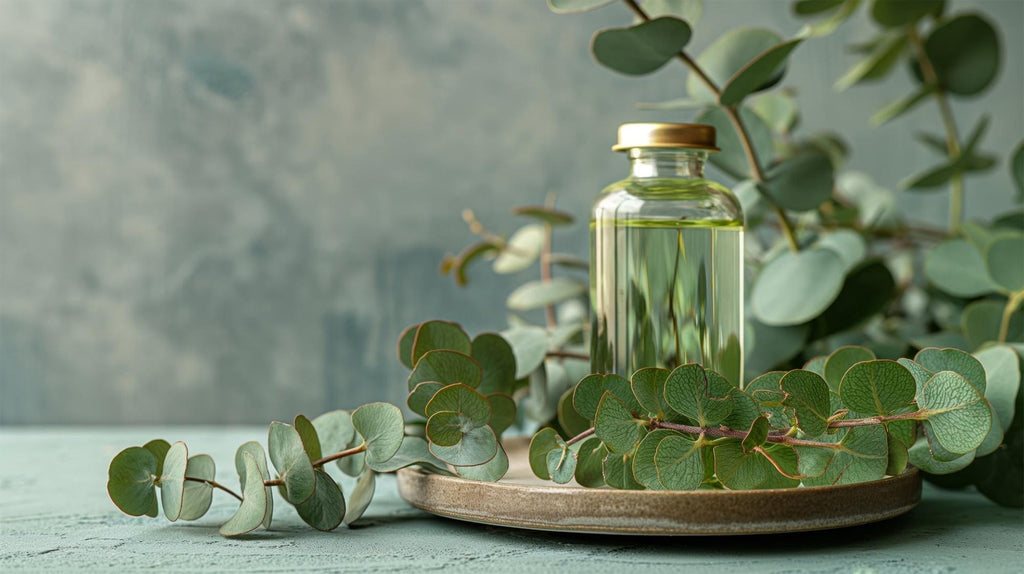
Benefits of Eucalyptus Oil in Baby Products: A Natural Ch...
Eucalyptus oil has been cherished for centuries for its healing and soothing properties. It’s a natural remedy often used in various health and wellness products. But did you know it can also be beneficial for your baby? In this blog, we’ll explore the benefits of eucalyptus oil for babies.
Eucalyptus oil infused products offer natural solutions and are gentle and safe for your little one.
What is Eucalyptus Oil?
Eucalyptus oil is extracted from the leaves of the eucalyptus tree. It is known for its refreshing scent and medicinal properties. This essential oil is often used in aromatherapy and is a popular ingredient in many natural health products. Eucalyptus oil can be a safe option for babies when used correctly and in appropriate amounts.
Instead of using the oil directly, it’s often more effective and safer to use products that incorporate eucalyptus as an ingredient. This ensures the oil is diluted to the right concentration, making it gentle enough for your baby’s delicate skin and sensitive system. Many baby products, such as vapor rubs and natural floor cleaners, include eucalyptus oil for its therapeutic benefits while ensuring it’s safe for everyday use. Let’s explore some of these benefits in more detail.
Benefits of Eucalyptus Oil in Baby Vapor Rubs
When your baby has a cold or feels congested, it can be really tough to see them uncomfortable. Baby vapour rubs containing eucalyptus oil can be a gentle and effective way to help relieve this discomfort.
-
Natural Decongestant
Eucalyptus oil acts as a natural decongestant. When applied to the chest or back, the soothing vapours can help to clear your baby’s nasal passages, making it easier for them to breathe. This is especially useful during colds or flu. -
Promotes Relaxation
The calming scent of eucalyptus oil can help your baby relax and sleep better. This is particularly helpful when your baby is restless due to illness. -
Safe for Sensitive Skin
Baby vapour rubs that contain eucalyptus oil are typically formulated to be gentle on sensitive skin. They are usually free from harsh chemicals, making them safer for your baby. -
Boosts Immunity
Eucalyptus oil is known for its antimicrobial properties. Products containing this oil can help protect your baby from germs and bacteria, boosting their immunity.
Eucalyptus Oil in Natural Floor Cleaners
When you have a baby, keeping the home clean is a top priority. Babies spend a lot of time on the floor, crawling and playing, so it’s important to ensure that the surfaces are free from harmful chemicals. This is where natural floor cleaners with eucalyptus oil come in.
-
Natural Disinfectant
Eucalyptus oil is a powerful disinfectant. It can effectively kill bacteria and viruses on surfaces when used in floor cleaners. This ensures that your baby is crawling on clean and safe floors. -
Safe for Babies
Unlike conventional floor cleaners that may contain harsh chemicals, natural floor cleaners with eucalyptus oil are free from toxins. This makes them safe for your baby to be around, reducing the risk of allergies or skin irritation. -
Pleasant Aroma
The fresh scent of eucalyptus oil leaves your home smelling clean and natural. It’s a great alternative to synthetic fragrances that can sometimes be overwhelming or irritating.
How to Use Eucalyptus Oil-Based Baby Products Safely?
While eucalyptus oil has many benefits, it’s important to use it safely, especially with babies.
-
Choose Baby-Specific Products
Always choose products that are specifically designed for babies. These products contain the right concentration of eucalyptus oil, ensuring that they are safe for your little one. -
Patch Test
Before using any new product on your baby, it’s a good idea to do a patch test. Apply a small amount of the product on a small area of your baby’s skin to check for reactions. -
Follow Instructions
Always follow the instructions on the product label. Use the recommended amount and avoid applying it too close to the baby’s face, especially around the eyes and nose. -
Consult Your Pediatrician
If you’re unsure about using eucalyptus oil products on your baby, consult your paediatrician. They can provide guidance based on your baby’s health and needs.
Additional Benefits of Eucalyptus Oil
Eucalyptus oil offers more than just respiratory and cleaning benefits. Here are a few more reasons to consider eucalyptus oil in your baby products:
-
Insect Repellent
Eucalyptus oil can act as a natural insect repellent. Products containing this oil can help keep mosquitoes and other insects away from your baby. -
Supports Respiratory Health
In addition to vapour rubs, eucalyptus oil can also be found in humidifiers and diffusers. These devices can help maintain healthy respiratory function by keeping the airways clear.
Eucalyptus oil is a natural, effective, and safe ingredient to include in baby products. Remember to always use these products as directed and consult your paediatrician if you have any concerns. Your baby deserves the best, and natural choices like eucalyptus oil are a step in the right direction.
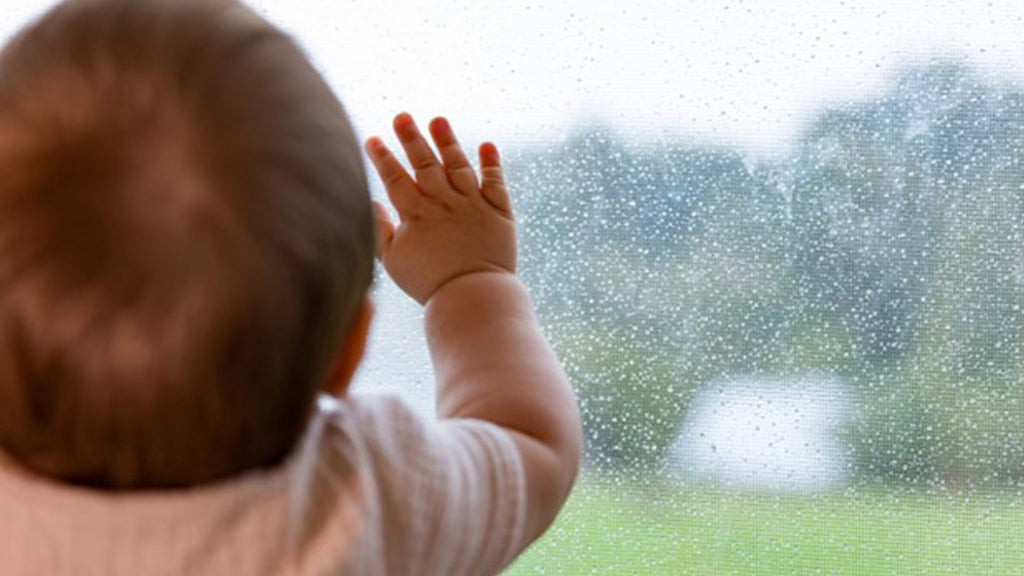
Must-Have Baby Essentials for a Safe and Comfortable Monsoon
The monsoon season brings with it a refreshing break from the heat, but it also introduces new challenges for parents of young babies. High humidity, increased moisture, and cooler temperatures can affect your baby's comfort and health. Preparing with the right baby essentials can make a big difference in ensuring your little one stays safe and comfortable during the rainy season. Here's a detailed guide on must-have baby products for a safe and comfortable monsoon.

Essential Baby Products for this Monsoon
Talc-Free Baby Powder
During the monsoon, the increased humidity can cause your baby to sweat more, which can lead to heat rashes and discomfort. A talc-free baby powder is essential to keep your baby's skin dry and prevent rashes. The Dulaar Pyar Baby Powder is made from natural ingredients like corn starch and oats kernel, which are gentle on your baby's delicate skin. This talc-free powder helps absorb excess moisture and reduce friction, keeping your baby's skin smooth and dry throughout the humid season.

Baby Vapour Rub
Monsoon weather often brings cooler temperatures and can exacerbate colds and respiratory issues in babies. A baby vapour rub is a must-have during this monsoon. The Komal Shwaas Baby Vapour Rub is formulated for infants and contains natural ingredients like eucalyptus and lavender oils. These ingredients help relieve nasal congestion, making breathing comfortably easier for your baby. Apply a small amount on your baby's chest, back, and soles of their feet before bedtime to help them sleep better during cold and damp nights.

Baby Rash Healing Cream
Wet weather and frequent diaper use can increase the likelihood of diaper rashes. A baby rash healing cream must be on hand during monsoon. Baby Forest’s Komal Kawach Diaper Rash Healing Cream contains Kusha, Harachampaka Madanah, and Geranium oil that creates a protective layer and keeps the baby’s skin soft, dry and supple. It also includes soothing ingredients like Aloe Leaf Juice and Jojoba oil. Regularly applying a rash cream can prevent rashes from developing and ensure that any existing rashes heal quickly.

Natural Floor and Baby Toy & Surface Cleaner
Monsoon season often brings mud and dirt indoors, increasing the risk of germs and bacteria that can affect your baby's health. A natural floor cleaner and, a baby toy & surface cleaner are vital for keeping your home clean and safe for your baby. The Swaksh Bhoomi Natural Floor Cleaner is made from natural, non-toxic ingredients, ensuring your baby is not exposed to harsh chemicals. This cleaner disinfects floors and surfaces, providing a hygienic environment for your baby to crawl and play safely. Similarly, the Swaksh Khilone Baby Toy & Surface Cleaner is designed to keep toys and surfaces free from germs, using non-toxic ingredients. Regular use of these cleaners helps maintain hygiene and reduces the risk of infections, especially during the monsoon when mold and mildew can thrive.

Pashmina Baby Blanket
Keeping your baby warm and cozy during the cooler monsoon months is important. A Pashmina baby blanket is an excellent choice for this purpose. Our Kashmiri Pashmina Baby Blanket is made from incredibly soft pashmina wool, which is lightweight and provides excellent insulation. These blankets are perfect for wrapping your baby during naps or bedtime, offering warmth without overheating. Pashmina blankets are also breathable, preventing your baby from getting too hot and ensuring they stay comfortable. Its luxurious feel makes them a comforting and soothing choice for your baby.

Baby Swaddles
Swaddling helps babies feel secure and improves their sleep quality, which is especially beneficial during the monsoon when the weather can be unpredictable. Baby swaddles made from soft, breathable fabrics like cotton or muslin are ideal. The Komal Aavran Baby Swaddle is made from soft, breathable fabric that helps regulate your baby's body temperature, preventing overheating while keeping them snug. Swaddling can also reduce the startle reflex, which often wakes babies up.

Baby Towel
When it comes to keeping your baby dry and comfortable after baths, the Somya Aanchal Baby Towel is an excellent choice. This towel offers exceptional absorbency and softness, made with a blend of 60% zero-twist cotton and 40% bamboo. The hooded design adds a touch of cuteness and ensures your baby's head stays warm, which is especially important during the cooler monsoon months. Generously sized for ample coverage, this towel is gentle on your baby's delicate skin and provides the ultimate comfort after bath time.

Additional Tips for a Safe and Comfortable Monsoon
-
Maintain a Clean Environment
Regularly clean your baby's room and play areas to prevent mold and mildew, which thrive in humid conditions. -
Dress Appropriately
Dress your baby in lightweight, breathable clothing to prevent overheating. Layering is a good strategy, as you can easily add or remove layers based on the temperature. -
Monitor Humidity Levels
Use a dehumidifier to control indoor humidity levels. High humidity can cause discomfort and promote the growth of mold and bacteria. -
Stay Dry
Ensure your baby stays dry by promptly changing clothes and diapers. Wetness can cause skin irritation and rashes.
Preparing for the monsoon season with the right baby products can significantly improve your baby's safety and comfort. Each item plays a crucial role in addressing the unique challenges of the rainy season, from talc-free baby powder to keep their skin dry to a pashmina baby blanket for warmth. Incorporating these products into your daily routine will help you easily navigate the monsoon, keeping your baby happy, healthy, and comfortable. Remember, the key to a stress-free monsoon is preparing and choosing high-quality products catering to your baby's needs.

Buying a Baby Towel? Here’s what you need to know!
Choosing the right baby towel is essential for your baby's comfort and hygiene. With so many options available, it can be overwhelming to decide which towel is best for your little one. In this guide, we'll explore the key factors to consider before purchasing a baby bath towel, ensuring you make an informed decision that keeps your baby warm, dry, and comfortable.
Factors to Consider While Purchasing a Baby Bath Towel:
Soft and Comfortable
One of the most important features to look for in a baby towel is its softness. A soft bath towel for a baby is gentle on your baby's delicate skin, reducing the risk of irritation and discomfort. Babies have much more sensitive skin than adults, so using a towel that is soft and plush can make bath time a pleasant experience.
When shopping for a baby bath towel, consider the material. Towels made from natural fibres like cotton are usually softer and more comfortable. A cotton towel for a baby is an excellent choice because it is not only soft but also breathable, ensuring your baby's skin stays healthy and free from rashes.
Highly Absorbent
The primary function of a towel is to dry, so it's crucial to choose a baby towel that is highly absorbent. After a bath, you want to be able to dry your baby quickly and efficiently to prevent them from getting cold. Look for towels that are thick and have a high absorbency rate, as these will soak up moisture effectively.
Materials like cotton and bamboo are known for their excellent absorbency. A blend of these materials can offer superior performance. For instance, our baby towel combines 60% zero-twist cotton, and 40% bamboo providing exceptional absorbency, making it ideal for drying your baby quickly after a bath.
Eco-Friendly
In today's world, making eco-friendly choices is more important than ever. When selecting a baby bath towel, consider the environmental impact of the product. Towels made from organic cotton or bamboo are great eco-friendly options. These materials are sustainable and biodegradable, reducing your environmental footprint.
Organic cotton is grown without harmful pesticides and chemicals, making it safer for your baby and better for the environment. Bamboo is another excellent choice as it grows quickly without the need for fertilizers or pesticides. Choosing an eco-friendly cotton towel for your baby not only benefits the planet but also ensures that your baby's skin is not exposed to harmful substances.
Durable
Durability is another crucial factor to consider when buying a baby towel. Babies can be messy, and their towels will need frequent washing. A durable towel will withstand repeated laundering without losing its softness or absorbency.
High-quality towels made from strong fibers like cotton and bamboo are more likely to remain in good condition over time. Investing in a durable soft bath towel for your baby means you won't have to replace it frequently, saving you money in the long run.
Hooded Towel for Baby
A hooded towel for the baby adds an extra touch of practicality and cuteness to bath time. The hood helps keep your baby's head warm after a bath, which is especially important for young babies who can lose heat quickly. A hooded towel also makes it easier to wrap and dry your baby, ensuring they stay snug and comfortable.
Hooded towels come in various designs and sizes, so you can choose one that best fits your baby's needs. The hooded design not only looks adorable but also provides additional warmth and coverage, making it a must-have item for bath time.
Why Choose Somya Aanchal Baby Towel?
Choosing the Somya Aanchal Baby Towel ensures you're providing your baby with the best in comfort, absorbency, and eco-friendliness. This towel stands out because it combines the softness of 60% zero-twist cotton with the sustainability of 40% bamboo, making it exceptionally gentle on your baby's delicate skin. The generous size offers ample coverage, keeping your baby warm and cosy after bath time. The hooded design not only adds an adorable touch but also provides extra warmth for your baby's head. Additionally, the high absorbency of the Somya Aanchal Baby Towel ensures quick drying, making it an essential item for every new parent who values quality and practicality.

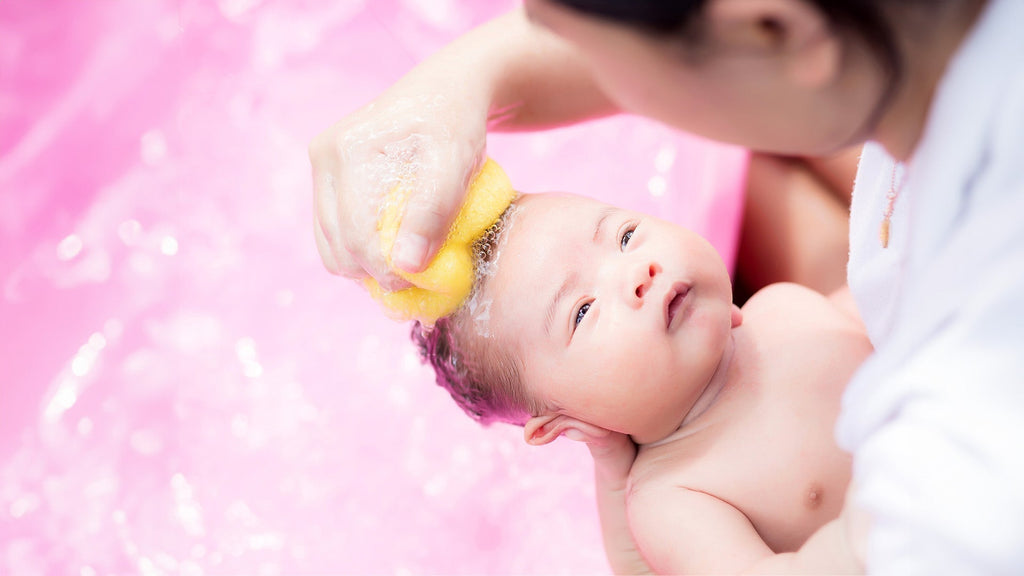
A Comprehensive Guide to Wash Your Baby’s Hair
Washing your baby’s hair might seem daunting, especially for new parents. However, with the right techniques and products, it can be a gentle and enjoyable experience for you and your baby. This guide will provide detailed steps on how to properly wash your baby’s hair, ensuring their scalp remains healthy, and their hair stays soft and clean.
Why Washing Your Baby’s Hair is Important
Regularly washing your baby’s hair is essential for several reasons:
-
Hygiene
It helps to remove dirt, sweat, and excess oils that can accumulate on the scalp. -
Comfort
A clean scalp reduces the likelihood of itchiness and discomfort. -
Health
Proper washing can prevent conditions like cradle cap, a common infant scalp issue.
How Often Should You Wash Your Baby’s Hair?
The frequency of washing your baby’s hair depends on their age and hair type:
-
Newborns
For newborns, washing their hair once or twice a week is sufficient since they don’t produce much oil. -
Older Babies and Toddlers
As your baby grows and becomes more active, you might need to wash their hair 2-3 times a week or as needed.
Choosing the Right Baby Shampoo
Selecting the right shampoo is crucial for maintaining your baby’s hair and scalp health. Here’s what to consider:
-
Gentle Formula
Opt for baby shampoos that are specifically formulated for babies. These are usually tear-free and mild, avoiding harsh chemicals that can irritate the scalp. -
Organic Baby Shampoo
Organic baby shampoos are an excellent choice as they are free from synthetic fragrances, dyes, and harmful chemicals. They often contain natural ingredients like aloe vera, coconut oil, and neem extract, which are soothing and nourishing for your baby’s delicate scalp.
Why Choose Organic Baby Shampoo?
-
Safe Ingredients
Organic baby shampoos are made from natural, safe ingredients less likely to cause allergic reactions or skin irritation. -
Eco-Friendly
These products are produced using environmentally friendly practices and are biodegradable, reducing their environmental impact. -
Nourishing
Natural organic shampoo ingredients can nourish your baby’s hair and scalp, promoting healthy growth.
Preparing for the Hair Wash
Before you start washing your baby’s hair, gather all necessary supplies to ensure a smooth process:
-
Baby Shampoo
Choose a gentle or organic baby shampoo. -
Soft Washcloth or Sponge
For gentle cleansing. -
Cup or Rinse Bottle
For pouring water over your baby’s head. -
Towel
A soft, absorbent towel for drying your baby’s hair.
Steps to Properly Wash Your Baby’s Hair
1. Create a Calm Environment:
Choose a warm, comfortable room for the bath. Make sure you have everything within arm’s reach to avoid leaving your baby unattended.
2. Support Your Baby’s Head:
Gently cradle your baby’s head with one hand while supporting their body with the other. You can either hold them in your arms or lay them on a padded surface like a bath cushion or a sink insert.
3. Wet Your Baby’s Hair:
Using a cup or rinse bottle, gently pour warm water over your baby’s head. Ensure the water is at a comfortable temperature (around 37-38°C or 98-100°F).
4. Apply Shampoo:
Squeeze a small amount of baby shampoo onto your hand and gently massage it into your baby’s scalp using your fingertips. Be gentle to avoid causing any discomfort. Focus on the scalp rather than the hair itself, as the scalp is where oils and dirt accumulate.
5. Rinse Thoroughly:
Rinse your baby’s hair thoroughly with warm water, ensuring all the shampoo is washed away. Residual shampoo can cause irritation or dryness.
6. Dry Gently:
Wrap your baby in a soft, absorbent towel and gently pat their hair dry. Avoid rubbing, as this can damage their delicate hair and scalp.
Tips for a Stress-Free Hair Washing Experience
Make It Fun:
Turn hair washing into a fun activity by singing songs, talking to your baby, or using bath toys to distract them.
Be Consistent:
Establish a routine so your baby knows what to expect. Consistency can make the process smoother and less stressful over time.
Be Patient:
Your baby might not enjoy hair washing at first, but with patience and gentle handling, they will gradually get used to it.
Use Minimal Products:
Babies have sensitive skin, so it’s best to use minimal products. Stick to a gentle shampoo and avoid using conditioner or other hair products unless necessary.
Handling Common Challenges
Cradle Cap
If your baby has a cradle cap (a common condition characterized by flaky, crusty patches on the scalp), you can gently massage a bit of baby oil onto the scalp before shampooing. This helps to loosen the flakes. Use a soft brush to gently remove the flakes during shampooing.
For more information on cradle cap, you can read this detailed guide - Dealing with Cradle Cap: Causes, Treatment Options, and Proactive Prevention
Fear of Water
Some babies are afraid of water being poured over their heads. To minimize discomfort, pour water slowly and shield their eyes with your hand. Using a rinse bottle with a spout can help direct the water flow more precisely.
Sensitive Scalp
If your baby has a particularly sensitive scalp, consult your pediatrician before using any new products. They might recommend a specific shampoo or provide additional care tips.
Properly washing your baby’s hair is an important part of their hygiene routine. By choosing the right products, such as organic baby shampoo, and following gentle techniques, you can ensure that hair washing is a comfortable and enjoyable experience for both you and your baby. Remember, patience and consistency are key to making hair washing a smooth part of your baby’s bath time. With these tips, you can keep your baby’s hair clean, healthy, and happy.

Tips to Choose the Best Baby Lotion For Your Newborn
Baby grooming products must be chosen with the utmost care since a baby’s skin is extremely delicate and soft. But choosing the best skincare for babies is crucial when there are so many options with the number of claims. What would be the proper process to pick the best for your baby?
A lot of baby products with decent fragrances sometimes contain paraben, alcohol, artificial fragrance, etc., which can be harmful to a baby’s sensitive skin.
Among various essential baby skin care products such as shampoo, hair oil, massage oil, etc., let’s explore choosing the best body lotion for babies. Body lotion helps moisturize a child's skin and preserve its natural moisture. Thus, it is crucial to pick body lotion for infants thoughtfully.
How to Choose the Best Body Lotion for Your Baby?
Everyone has a different skin type and texture. Likewise, a baby’s skin is also different. Their pH level is different from adults, as is their skin, which is also more sensitive. Since babies’ skin is very delicate, they tend to have dry skin or may face the problem of eczema.
If you are unaware of your baby’s skin type, you might want to look for a body lotion that is hydrating and treats sensitive skin like a charm. Baby Forest has the ideal body lotion, which could be used on dry, sensitive skin or conditions like eczema, psoriasis, and rashes.
Best Body Lotion For Baby’s Dry Skin
If your baby has dry skin, flakiness, redness, and itchiness are the signs to look for. It is best recommended to get body lotions that are hydrating in nature. Always pay attention to the product composition. Ingredients like Shea Butter and Coconut Oil are known to hydrate the skin thoroughly & naturally lock the moisture. Hence, baby lotions with natural ingredients are highly recommended for your baby’s dry skin as they are not harsh on the skin.
Best Body Lotion For Baby’s Sensitive Skin
If your baby has sensitive skin, avoid choosing a body lotion with artificial fragrances, parabens, and chemicals. Products with these substances tend to irritate sensitive skin more than they do any good. Hence, it is recommended to choose baby lotions with 100% natural ingredients and no artificial fragrance.
Check the Product Labeling
While choosing a body lotion for your little one, ensure the product you pick is dermatologically tested. Checking the product label can help determine the purity of that product. Moreover, it is recommended to avoid thick body lotions as they take more time to absorb into the skin. Since babies’ skin is sensitive, this might irritate them. Hence, choosing a body lotion that is lightweight in texture can work wonders on your baby’s skin.
Choose Organic & Natural Body Lotion
Nothing works better than employing natural remedies to maintain the body's natural heat. Since a baby’s skin is sensitive, using organic and natural body lotions is helpful.
You can check out Baby Forest, which provides the purity of nature blended with the wisdom of Ayurveda for your baby’s delicate skin. Head to our website to check out the best Baby Forest's Moh Malai Baby Body Lotion for your little one and keep those sweet cheeks giggling all the time.



